Revolutionising leachate management
WaterGroup
future shaping the of water

WaterGroup future shaping the of water
Insights into sensors and IoT devices for a better water future
Insights into sensors and IoT devices for a better water future

Sailing the seas of safety and wellbeing
Sailing the seas of safety and wellbeing
Optimism key to a happier workforce
Optimism key to a happier workforce

ISSUE 08
2023
SEPTEMBER/OCTOBER
.com.au ISSUE 08
2023
SEPTEMBER/OCTOBER
Revolutionising leachate management
Discover how we took on the sand and sea to rehabilitate a beachside structure
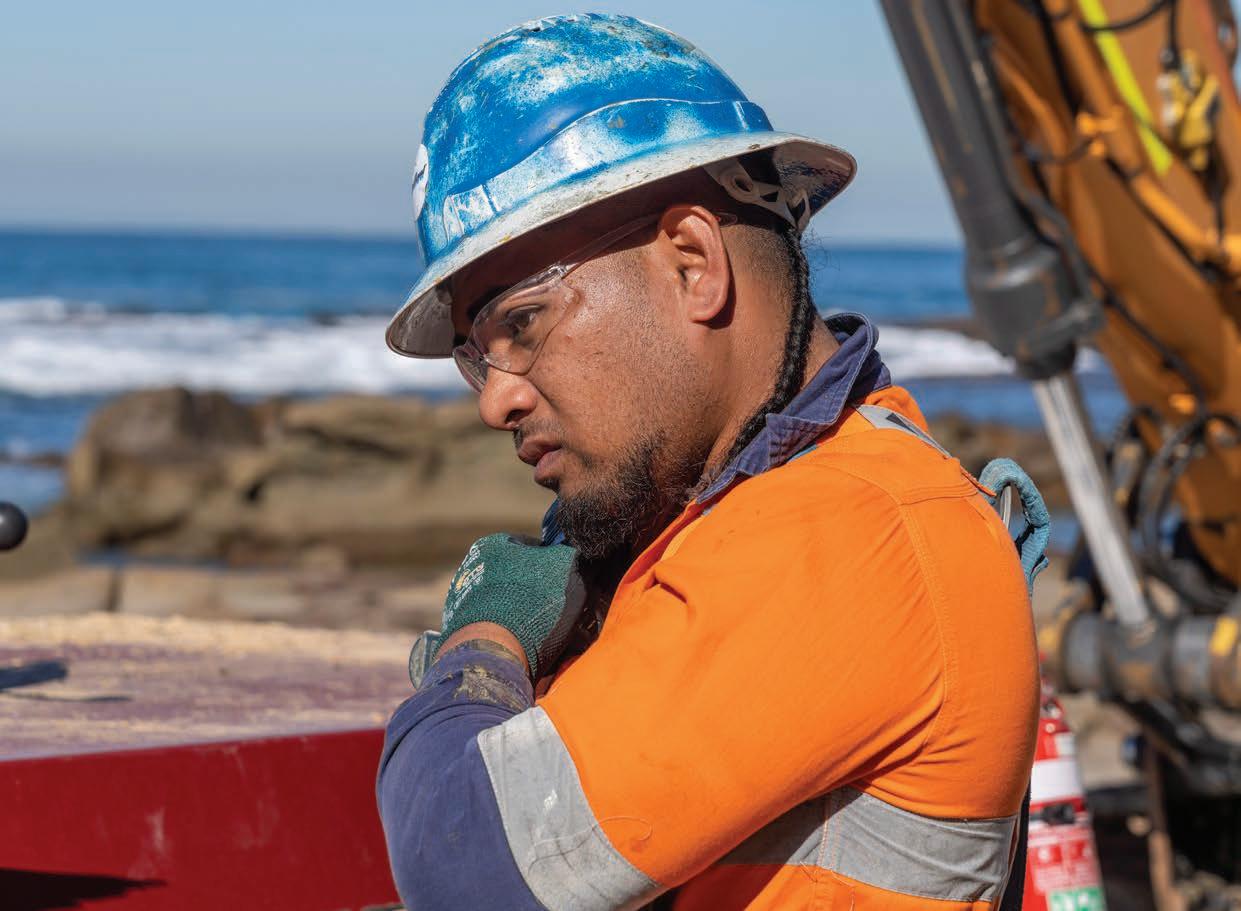
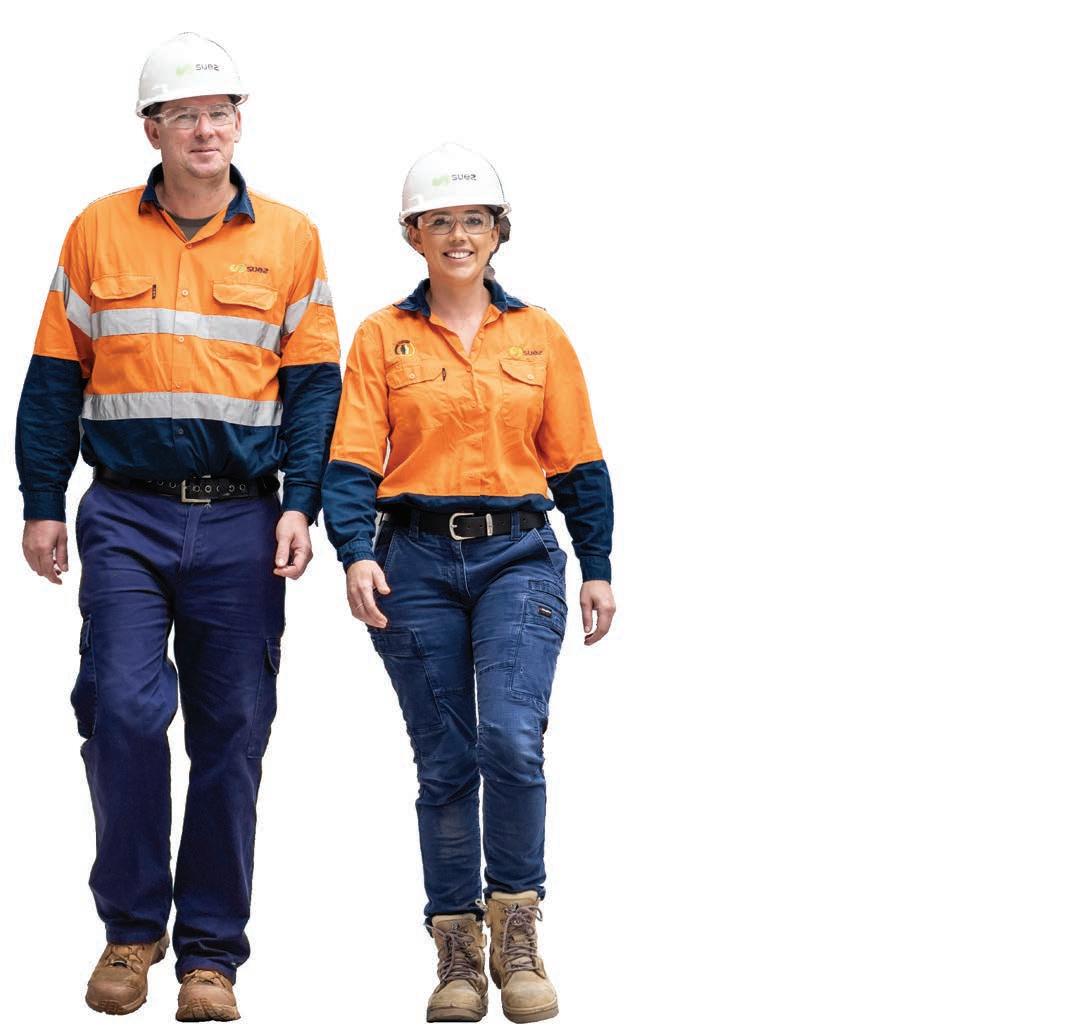


We’re Creating the Future of Water through creative pipeline solutions
We’re Creating the Future of Water through creative pipeline solutions







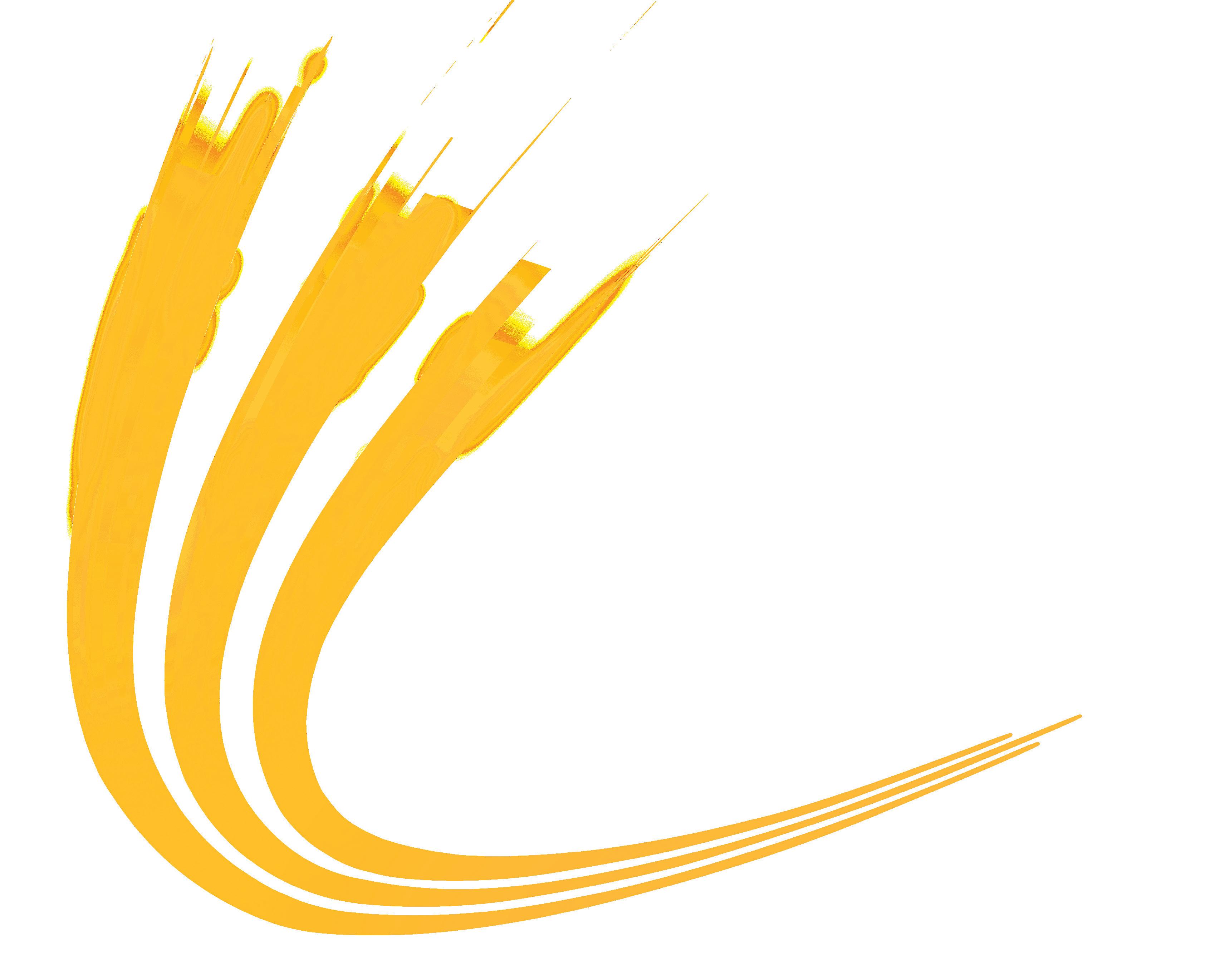



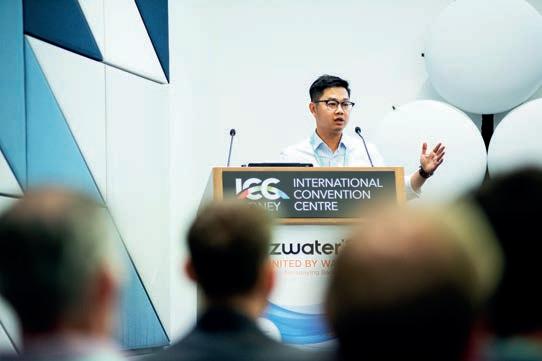

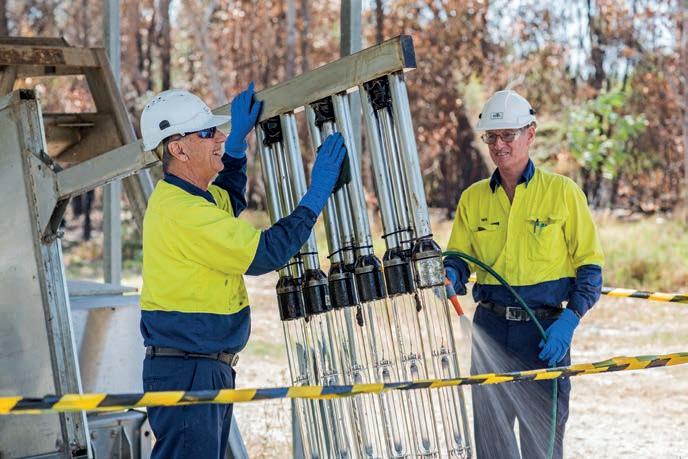

www.insidewater.com.au INSIDE WATER 3 CONTENTS Issue 08: September/October 2023 4 Editor’s Note COVER STORY 6 WaterGroup WaterGroup shaping the future of water through Internet of Things YOUNG PROFESSIONAL 10 Mikayla Rodger Slaying algal blooms with the sun and recyclable products 14 Minh Duc Nguyen No wasting time for award winner and waste researcher INDUSTRY INSIGHT 16 Annette Davison Assessing risk with Annette and the Risk Group ASSOCIATIONS 54 VicWater Optimism central to a happier workforce in the water industry LAST WORD 58 The lighter side of water WASTEWATER 18 Aerofloat Revolutionising leachate management 22 Hydroflux The changing face of wastewater in Australia 24 Pulsar Understanding the different types of sensors for the wastewater industry 26 Xylem Xylem’s wastewater approach provides solutions for the industry at all levels 28 Polymaster Polymaster providing proper solutions 30 Interflow Mereweather upgrade for merry weather WATER MANAGEMENT 36 NT Government Water planning in the Northern Territory on track REGULAR FOCUS 14 26 38 48 WORKFORCE MANAGEMENT 38 SUEZ ANZ Sailing the seas of safety and well-being 42 Voeu Measure, benchmark and improve SOFTWARE 44 South East Water Map it out for biodiversity SENSORS 48 Taggle Gladstone invests in advanced water metering PRODUCTS 50 kwik-ZIP Barwon Water implements spacers and centralisers EVENTS 48 Women in Industry Awards 2024 Women in Industry Awards head to Sydney in 2024
EDITOR’S Note
Flush with success
WHEN WE FIRST launched Inside Water in the middle of last year, I did not anticipate how much I would learn about what some have dubbed as the dirty side of the water industry.

That’s a literal turn of phrase –wastewater is dealing with waste in all its elements. It struck me to think about how there is both a clean and dirty side. While I acknowledged that both were different, it was not until I started working in the industry that I realised how important the wastewater industry is to Australia.
WaterGroup is one of the largest integrated corporate water savings companies in Australia. What is less discussed is the group of Guenter Hauber-Davidson, Aimi Macready, and Holly Guy. These three business unit leaders are having a significant impact on the growth of the company as WaterGroup leverages the Internet of Things, innovation and sustainable solutions.
Also, in this issue, we talk to Mikayla Rodger. One thing that everyone likes to hear about is award winners, particularly given the collegiate attitude across the industry. Rodger is a student of Meriden School who recently represented Australia at the Stockholm Junior Water Prize. Her development of a cost-effective and recyclable device to prevent algal blooms in farm water offers enormous potential across Australia.
Further to that, Minh Duc Nguyen won the Student Water Prize at OzWater’23, the premier event for the water industry. The Australian Water Association has long given young water professionals the opportunity to shine. Nguyen’s research at Deakin University into biosolids has shown that every researcher can stand out in different ways.
We also look at risk. Risk is a basic component of life, but how does a business assess all its risks and work
to minimise their negative impacts?
Dr Annette Davison has been involved in the industry for a long period, and The Risk Group is taking a leading role in supporting business in its understanding of its risks.
Managing wastewater is a challenging task, particularly given the range of regulations at the local, state, and federal levels designed to protect the population. It’s why companies like Aerofloat, Hydroflux, Xylem, Polymaster and Interflow play a critical role in supporting local councils and water authorities in keeping people safe and finding valuable resources from waste.
While moving sideways from wastewater, I had the pleasure of interviewing one of the most optimistic people I have ever spoken to. Victor Perton could be the most optimistic person in the world, and his thinking about how optimism impacts workforce management was incredibly insightful. If you ever get the opportunity to meet Victor, grab it with both hands.
As we move into our second year, we are still a young publication. However, the continued interest by the industry in Inside Water is immensely promising. We are rapidly approaching 2024, and I have no doubt that the partnerships we have developed with the industry will continue to grow.
Chief Executive Officer John Murphy john.murphy@primecreative.com.au

Chief Operating Officer Christine Clancy christine.clancy@primecreative.com.au
Group Managing Editor Sarah Baker sarah.baker@primecreative.com.au
Managing Editor Mike Wheeler mike.wheeler@primecreative.com.au
Editor Chris Edwards chris.edwards@primecreative.com.au
Design Daz Woolley/Tom Anderson
Head of Design Blake Storey blake.storey@primecreative.com.au
Design Production Manager Michelle Weston michelle.weston@primecreative.com.au
Brand Manager Chelsea Daniel chelsea.daniel@primecreative.com.au p: +61 425 699 878
Client Success Manager Glenn Delaney glenn.delaney@primecreative.com.au
Head Office Prime Creative Pty Ltd 379 Docklands Drive, Docklands, Victoria 3008 p: +61 3 9690 8766 f: +61 3 9682 0044 enquiries@primecreative.com.au www.insidewater.com.au
Subscriptions +61 3 9690 8766 subscriptions@primecreative.com.au
Inside Water is available by subscription from the publisher. The rights of refusal are reserved by the publisher
Articles
All articles submitted for publication become the property of the publisher. The Editor reserves the right to adjust any article to conform with the magazine format.
Copyright Inside Water is owned by Prime Creative Media and published by John Murphy.
All material in Inside Water is copyright and no part may be reproduced or copied in any form or by any means (graphic, electronic or mechanical including information and retrieval systems) without written permission of the publisher. The Editor welcomes contributions but reserves the right to accept or reject any material. While every effort has been made to ensure the accuracy of information, Prime Creative Media will not accept responsibility for errors or omissions or for any consequences arising from reliance on information published. The opinions expressed in Inside Water are not necessarily the opinions of, or endorsed by the publisher unless otherwise stated.
4 INSIDE WATER September/October 2023

WaterGroup shaping the future of water
Aimi Macready, Head of Sales and Marketing at WaterGroup, Holly Guy, Head of Smart Metering Operations, and Guenter Hauber-Davidson, Managing Director, provide insights into implementing sensors and IoT devices for a better water future.

“AS A SMALL child, I could never walk past a trickle of water without playing in it, much to my mother’s great dismay. I’ve always had an affinity for water. This might suggest that I would have become a dam builder. Instead, I work to avoid the need for new dams.”
Guenter Hauber-Davidson has been instrumental in developing water conservation designs, tools, and models. To date, he has developed and delivered more than 100 water savings projects and a smart water meter. Hauber-Davidson
is among a handful of water conservation experts who can claim involvement in implementing largescale integrated water conservation schemes.
“I did initially start on the dirty side of water, focusing on wastewater,” said Hauber-Davidson. “However, during the first millennium drought, I found an opportunity to work in the water efficiency space. I’m a greenie at heart, so I loved the opportunity to work on managing water better.”
Starting WaterGroup
As one of the founders of WaterGroup, Hauber-Davidson’s goals for the company were to help the world with cost-effective and sustainable solutions that allow
6 INSIDE WATER September/October 2023
Cover Story WaterGroup
society to manage water better and more efficiently. In the intervening 17 years, he believes the overall solutions and goals remain the same. What has happened is a shift in focus around water efficiency and Internet of Things (IoT) devices.
“When we began 17 years ago, Australia was generally horrible at water efficiency,” he said. “Most Australians did not think about water because it just came out of the tap and was always there. When the Millennium Drought arrived after the Olympics, we saw our dams rapidly deplete; the Murray Darling River was just a series of ponds in some parts of Australia, and water dwindled everywhere across the country.”
Around this time, there was a
focus on water efficiency, which saw the introduction of dual flush toilets, water-efficient taps and showerheads, among other things. The implementation of this equipment was quickly followed by legislation and regulation, such as the Water Efficiency Labelling and Standards (WELS) scheme. According to the WELS scheme website, Australians could save more than $2 billion by 2030 through water-efficient products – working out at an average saving of $175 per household per year.
“The legislation and regulation very quickly eliminated the worst offenders when it came to water efficiency,” said Hauber-Davidson. “Then there was a lot of funding for rainwater and stormwater harvesting.”
Other involvement in WaterGroup
Similarly, Aimi Macready has been involved in technology for over 18 years. She is passionate about getting to the heart of individual
business needs, with over 25 years of experience working across world-class technology and related organisations. Macready is strongly determined to solve ongoing business challenges with the help of IoT-based solutions. When it comes to the water industry, she believes that it has advanced so much technologically.

“I like how technology creates better outcomes for people, businesses, and the environment,” said Macready. “I wanted to be a part of the water industry and its advancements.”
Holly Guy came into the water industry and smart metering field more recently. After finishing a job in the financial services industry, she wanted to find something new. With a progressive view of the industry and utilising the latest IoT and LPWAN technologies, she is set to successfully manage many of WaterGroup’s largest smart metering projects for key clients.

www.insidewater.com.au INSIDE WATER 7
Aimi Macready (left) and Holly Guy (right) are driving the future of water.
The devices installed by WaterGroup are proven Internet of Things (IoT) products.
Cover Story WaterGroup
“I wanted to work for a company that was actively investing in ways to revolutionise how we manage global resources,” said Guy. “I was lucky to come across a sales role at WaterGroup in 2019.”
She’s been with WaterGroup ever since and now heads up the smart metering operations team. She has moved quickly to develop a lot of knowledge. Her career path within WaterGroup has satisfied her desire to work on optimising water resource usage while enhancing environmental conservation.
Internet of Things
On reflection, Macready stumbled into the Internet of Things (IoT) industry. Her first role in a technology integration and consulting business had just started to talk about IoT in the early to mid-2000s.
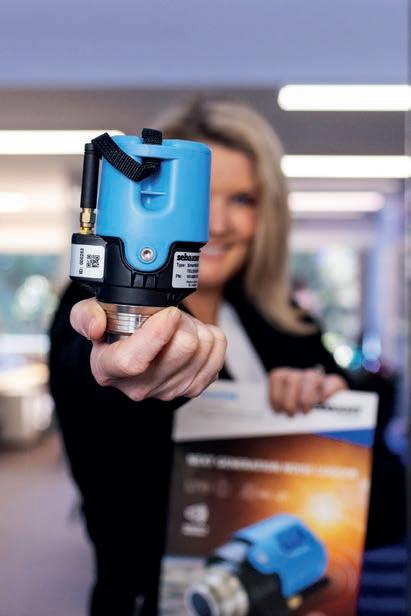
“I became more interested in IoT when I moved into the Connected Lighting Industry — it was a light bulb moment,” she said. “The intake and evolution of IoT has and continues to impact customers and businesses across lighting and water. Commercial, industrial, retail, and tertiary segments are, in my experience, the ones that have been benefiting the longest. Our case studies and results for these clients are hard proof that technology and the data it provides significantly impact how a business runs and becomes more sustainable.”
Guy believes that the smart water industry has changed significantly with the introduction of IoT technology.
“I’d say that’s significantly accelerated,” she said. “It has led to more advanced sensors and data analytic capabilities. In smart water monitoring, IoT has outpaced 3G or other radio networks due to energy efficiency, scalability, interoperability, and diversity in connectivity options.”
A treasure trove of data
“To be honest, we squandered a huge opportunity when the funding from the government for water harvesting and recycling schemes was available,” Hauber-Davidson said.
“We should have been monitoring and measuring all these systems. Imagine the treasure trove of data we could be sitting on now. Yet, we’ve barely scratched the surface of possibilities.”
Hauber-Davidson believes that understanding how systems funded have been operating has helped us to work out what has been achieved – and what has not.
Still, he believes we are now at a reasonable level of basic water efficiency. The focus now is on monitoring and understanding what is happening across the system.
“In water conservation, slow and steady loses the race, to coin a phrase,” said Hauber-Davidson. “If you have just a small leak of one litre a minute, it doesn’t look like much on its own. It is a fast-dripping tap but not a stream of water. Yet, it works out to nearly 1,500 litres a day. That is about as much water as 10 people use.”
Like Hauber-Davidson, Guy believes in the importance of examining the data. Understanding the data generated by smart IoT devices is critical for water utilities and municipal governments.
“Smart systems generate a lot of data,” said Guy. “Businesses that adopt smart monitoring need to have addressed how they will effectively manage the data coming in. WaterGroup places a lot of importance on ensuring our clients can interpret and use the data efficiently. As a company, we want our clients to instantly have access to the information they need without getting lost in the volume of data coming through.”
Water savings and software
She emphasised that while the basic water savings and water efficiency measures are now in place, the industry is moving to a high-tech level of monitoring. With all the software, monitoring, and IoT devices, the industry can understand what is happening, keep efficiencies high and avoid wastage.
“The advantages enable real-time monitoring, predictive maintenance, and seamless integration with existing infrastructure,” said Guy.
“We’ve seen an evolution in how we collect, analyse, and use the data we collect from meters.
WaterGroup is continuously gaining insights into our water networks which in turn is making us more efficient in the upkeep and
8 INSIDE WATER September/October 2023
The SmartEAR IoT Acoustic Logger helps reduce water loss and minimise water leakage.
“
I firmly believe that if we look after our water properly, there is plenty for everyone on this planet.
”
maintenance of those networks. One of the biggest advantages is improved resource management and customer satisfaction. We’re a society that thrives on having data at our fingertips, and software advancements are making it readily available, allowing us to action issues as they arise or even ahead of time.”
Guy’s involvement in the industry has seen the impact of software improve the quality of data received.
“I reckon software developments have ensured the data we’re receiving from smart meters is more user-friendly whilst being easily interoperable with other business technologies,” said Guy. “We’re part of the evolution of smart cities, so integration with multiple systems is a must for success. WaterGroup’s Software as a Service (SaaS) platform UtiliOS is one of the ways we ensure our clients negate the need for multiple systems. We maintain the capability of integrating with other software whilst providing a deviceagnostic platform allowing you to display all your smart monitoring data in one place.”
Technology supports savings
With the wide range of IoT devices available in the market, WaterGroup needs to understand many aspects of the systems in which they work. There are differences between the biggest and smallest installations.
“If we’re just dealing with a few points, we want devices that can connect through narrowband IoT (NB IoT),” Hauber-Davidson said. “Those devices, like our mobile phones, can connect to the existing telecommunications network. On the other hand, if we’re doing a mass rollout of hundreds or thousands of devices, we might look at long-range wide-area networks (LoRaWANs). Such a dedicated network can look after many devices.”
By using IoT devices, WaterGroup is trying to pick up when, where and how abnormal usage occurs. The data collected from sensors monitoring how water flows through a system can pick up unusual patterns. Artificial intelligence (AI) and machine learning can help identify where a leak might occur.
“Every leak has a pattern and a fingerprint,” Hauber-Davidson said.
“Our software and algorithms can pick that up and verify it through years of data monitoring and experience. We have spent enough time on those sites to know what is normal and abnormal. As a result, we can get pretty close to the cause of a leak and its location, saving money for our clients.”
The future for WaterGroup
Hauber-Davidson would like to see every single 40 mm and larger water meter monitored online. That would prevent any further undetected water leaks throughout Australia’s water network.
“We know when more water is used than necessary. AI can help streamline the procedures to make sure people know what to do,” he said. “As a company, we are working hard to automate these things to scale them up and become significantly bigger.”
WaterGroup has been around
since 2006. Hauber-Davidson, Macready, and Guy are part of a company known for its ability to address many of the water industry’s challenges. Macready pointed out how WaterGroup was the first to bring Australian Utilities a commercially ready NB-IoT, fully integrated, ultrasonic smart water meter, an industry favourite now.
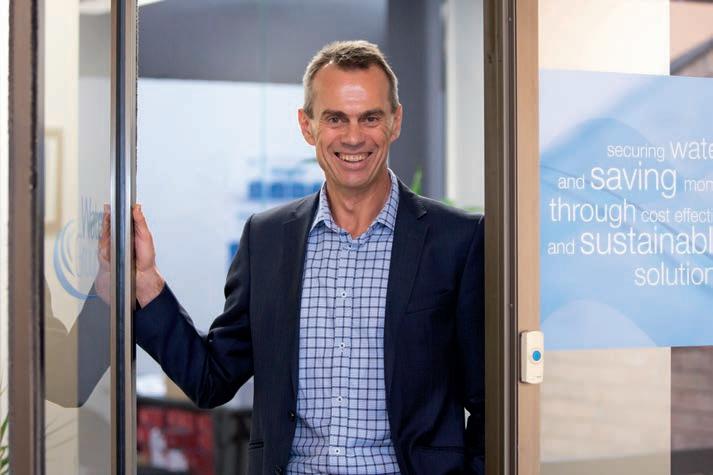
“We’re an effective team when it comes to communication, transparency and collaboration,” said Guy. “This is not just about communication between our clients but our providers too. I think that is what makes us one of the strongest companies in providing fully integrated end-to-end solutions. By embracing change, being adaptable and fostering a culture of innovation, we’re confident in our ability to positively impact water management in the future.
In looking forward, Macready is looking to its history. She knows that WaterGroup will continue to evolve and make an impact.
“With a progressive view of the industry and utilising the latest in IoT and LPWAN technologies, WaterGroup has won awards for excellence in this area,” said Macready.” We see water network monitoring as the next frontier.”
For more information, visit www.watergroup.com.au
www.insidewater.com.au INSIDE WATER 9
Guenter HauberDavidson is the managing director of WaterGroup.
Slaying algal blooms with the sun
The Australian Stockholm Junior Water Prize winner is a Year 10 student from Meriden School in New South Wales. Mikayla Rodger talked about her inspiration to tackle the problem of cyanobacteria and her future.
“I BELIEVE IT is important for young women to become more involved in STEM, pursue their interests and strive to make real change in the world around them,” said Mikayla Rodger, the 2023 Australian Stockholm Junior Water Prize winner.

Cyanobacteria is a microscopic phytoplankton responsible for an irreversible decline in water quality. Many substances deal with cyanobacteria, also known as bluegreen algae. Few deal with their root causes, which is where Rodger steps in.
A student at Meriden, Rodger won the prize due to her research investigating an eco-friendly and affordable system that could help prevent a cyanobacteria bloom. Her solar-powered machine, called SolarCyanoSlayer, can reduce cyanobacteria blooms by circulating, oxygenating, and filtering a body of water. The system, designed to be used by farming dams, is made from recycled materials and is suitable for both short- and long-term implementation.
“Mikayla started work on her machine in 2022,” said Meriden’s
Head of Science, Tara Richards. “She worked with her classroom teacher to expand on her original idea. Her original project ran for about 12 months as part of an application for the CSIRO CREST Awards.” Creativity in Research, Engineering, Science and Technology (CREST) is a national education program made available by CSIRO. It is designed for students in Years K to 12 to develop their science, technology, engineering, and mathematics (STEM) skills. Based on an inquiry approach to teaching and learning, students are engaged at all levels in science investigations and technology projects to progress from structured inquiry to open inquiry.
“Applying for the CREST Awards meant Mikayla had to make some adjustments to her original project and flesh out her proposal,” said Richards. “As part of the school’s annual Science Showcase, she got further feedback from the judges. That meant more fine-tuning before Mikayla came second in the Science Teachers Association of New South Wales (STANSW) Young Scientist
Awards in the Innovations and Engineering Design, Grades 9-10. She actually finished second to one of our other students.”
How did she get involved in this research?
“For me, science is a vessel for discovery. I get to learn about how things work and apply it to the world around me,” said Rodger. “Science allows me to question, explore and uncover. It provides results that can help to develop solutions to some of the world’s greatest challenges.”
Rodger has always been a fan of the outdoors. She is involved with some of Meriden’s extracurricular environmental clubs and programs. Finding herself an award winner was something unexpected.
“My research on cyanobacteria was not something I saw as a global issue,” she said. “Rather, I did a small project that evolved into something much bigger. It started with just a tub of cyanobacteria, and then I designed a system to help prevent them from occurring.”
Inspiration for Rodger came from spending time bushwalking. While walking, she came across a waterway covered in what she described as “this layer of murky green.” On returning home, Rodger discovered that it was cyanobacteria, which was devastating the local ecosystem.
“I did some research on the impact
10 INSIDE WATER September/October 2023
YOUNG PROFESSIONALS Mikayla Rodger
Mikayla Rodger and Meriden’s Head of Science, Tara Richards.
of cyanobacteria around the world. The Murray River in Australia has been devastated by it, and the Selwyn River in Canterbury, New Zealand, has had similar ecological damage. I looked at the Selwyn River as a case study, but it’s a global issue. I just thought I could do something about it,” she said.
In the words of the Australian Water Association, “Rodger’s project involved research into the causes of toxic cyanobacteria blooms and the development of a system that mitigates the risk. Cyanobacteria blooms plague global waterways and seriously impact the health of aquatic organisms, terrestrial animals, and humans. This threat is growing in prevalence alongside climate change.”
Rodger aimed to design a system that prevents uncontrolled cyanobacteria reproduction (a bloom event) while allowing natural populations to exist. Her design, the SolarCyanoSlayer, is also aimed to be self-sustaining for longterm implementation.
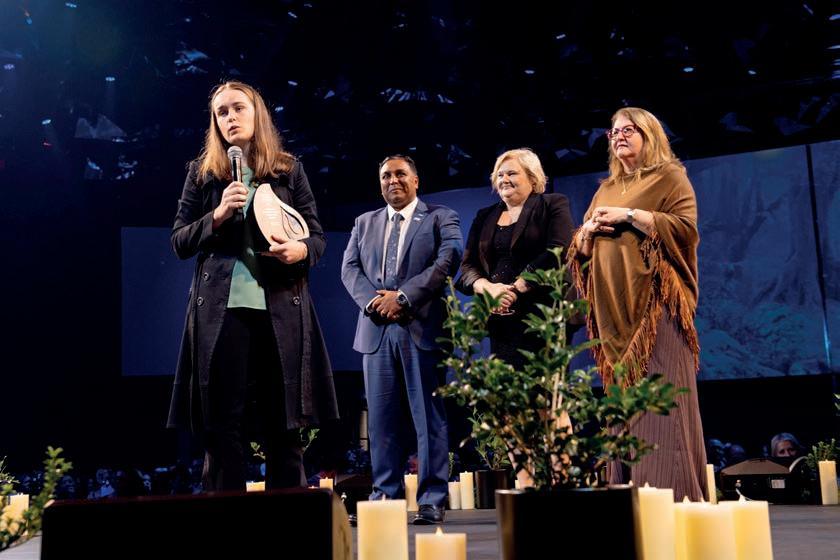
It was made of biologically derived and recycled materials, reducing the embodied energy of construction.
When placed in simulated eutrophic conditions, the invention was demonstrated to be highly effective in countering cyanobacteria blooms and subsequently improving overall water quality.
What did she want to achieve?
“There were three critical issues for me to deal with cyanobacteria,” she said. “The first is eutrophication, which represents too much phosphorus and nitrogen in the water. It normally comes about when the water is stagnant. The other two aspects are low oxygen levels and high water temperatures.”
When combined, these three factors result in the exponential
entirely made of recycled and biodegradable components,” she said. “This increases the viability of implementing it as something affordable and environmentally ethical. It’s made up of recycled PVC pipes, solar panels, biofilters and a pump.”
Rodger’s machine targets high mineral concentration with its biofilter. The solar panels power a low-level circulating pump and the oxygenator. The pump moves the water around to prevent stratification. Similarly, the oxygenator sucks in oxygen from the atmosphere and pumps it into the

small aquariums.
“The whole device is painted white. It’s a small decision, but the advantage is that there is less radiant heat transmitted into the water. This maintained the environmental quality of the device because it would not encourage further bacterial growth,” said Rodger.
When it comes to operating the biofilter, it is critical to prevent the growth of cyanobacteria. The oxygenator’s chemical reactions inhibit the bacteria’s development, reducing the algal blooms’ toxicity. It also works in tandem with the biofilter to prevent eutrophication.
www.insidewater.com.au INSIDE WATER 11
Water Prize at the Ozwater’23 Gala Dinner.
The SolarCyanoSlayer is solar-powered and can reduce cyanobacteria blooms.
YOUNG PROFESSIONALS Mikayla Rodger
Experimenting with cyanobacteria
Cyanobacteria is not something you can buy from a store. Rodger had to source it herself and then conduct her experiments. Collecting cyanobacteria was not a particularly difficult task.

“I went for a bike ride to a swamp that I know is prone to eutrophication and, therefore, algal blooms,” she said. “I had one tub with the cyanobacteria and a second tub as my control water. I also added some minerals to both tubs of water to try and simulate the conditions that would be present in farming dams. That meant adding fertiliser and minerals in the right concentration to ensure I could get as close as possible to what would happen in the real world.”
After adding those fertilisers and minerals, Rodger let both samples settle into place. That was when she was able to put her device into action. Solar power ensured that her devices would continue to operate without her presence, and she could check the progress where necessary.
The future of the SolarCyanoSlayer
Following her success at the Australian Water Awards, Rodger has received several offers to attend conferences and do work experience.
However, she is concentrating on attending the Stockholm Junior Water Prize in late August as part of World Water Week in Sweden.
“If there is any interest from companies in commercialising the design, I’ll deal with that once I get back from Stockholm,” she said. “That is where it will be presented on a global scale, and I can potentially have a larger impact.”
Another aspect of Rodger’s research is looking at the bacteria created in waterways after bushfires. With the large amounts of organic material and minerals ending up in the water, the SolarCyanoSlayer could become invaluable.
“This year, I worked a bit more on cyanobacteria that bloom after bushfires,” she said. “It’s essentially black water after a bushfire – that’s when the water goes completely black. It’s a different type of bacteria that blooms, but that’s because there are so many minerals in the organic matter. Think about the volume of burnt leaves, trees, and other organic materials – they all end up in the waterway. Bacteria will break that down and use up all the oxygen in the water. As a result, the bacteria will be able to bloom exponentially from that because it’s such a reliable food source.”
The role of Meriden
Meriden School is located in Strathfield in Sydney’s inner west. An Anglican day school for girls, it has a strong focus on STEM subjects, which is reflected in the success of Meriden in the Stockholm Junior Water Prize. Meriden student Annabelle Strachan won in 2021 by studying and developing a bioflocculant for reducing turbidity. The school’s performance matches those of Newton Moore Senior High School (2001 and 2002 winners as Newton Moore College) and the Illawarra Grammar School (2017 and 2019 winners. It lags only behind the Queensland Academy for Health Sciences (2011, 2012, 2015, and 2016 winners).
“Meriden is very passionate about STEM,” said Richards. “We continuously support our student’s ideas and provide them with as many options as possible, both in and out of the classroom. We want the students to explore their passions and develop a wide range of skills. In our science classes, many of our lessons are very practical and handson. We want the girls to collaborate, ask many questions, and conduct those investigations. Relating them to real-world applications is where they succeed in STEM subjects.”
12 INSIDE WATER September/October 2023
Mikayla Rodger presenting the SolarCyanoSlayer at Meriden’s Science Showcase.

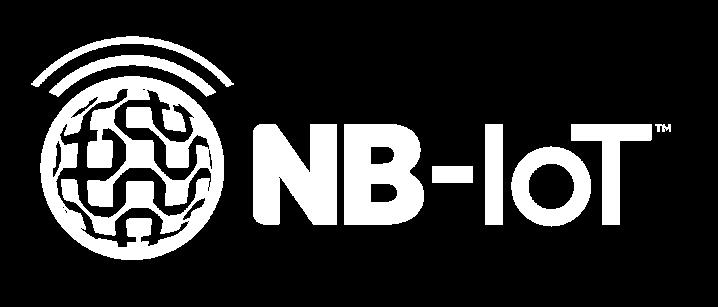

No wasting time for award winner and waste researcher
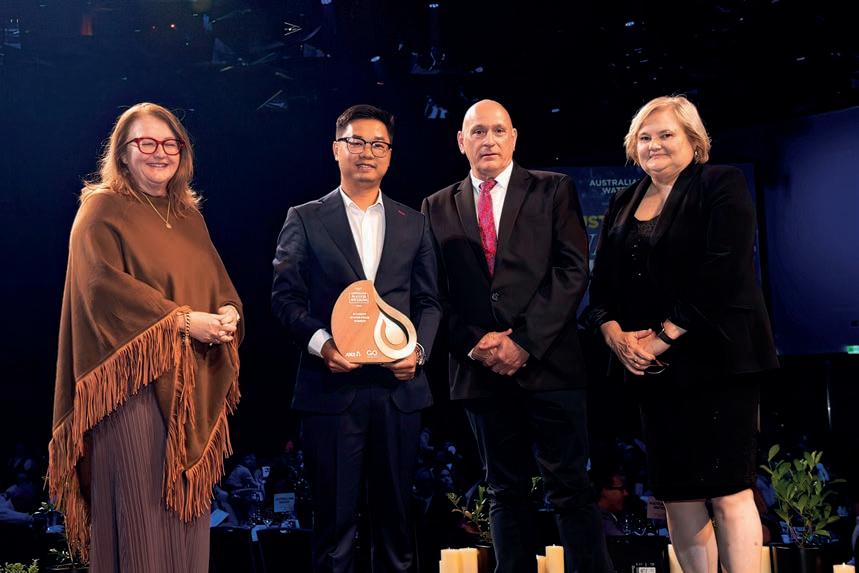
Fourteen years ago, Minh Duc Nguyen was completing his bachelor’s degree at Hanoi Architecture University. Now, he is a well-regarded water and wastewater engineering researcher, a consultant at Isle Utilities and the 2023 AWA Student Water Prize winner.

“WHEN I STARTED my career, I was very focused on water, specifically the drinking water side. It wasn’t until later that I realised that wastewater is not just waste, but a resource.”
These are the words of Minh Duc Nguyen. He has recently completed his PhD in the beneficial reuse of sludge from drinking water treatment process at Deakin University in collaboration with Barwon Water. Nguyen’s research examines how a cost centre for water utilities can be a source of revenue.
“I’m more interested in the recycling, circular economy and
said Nguyen. “When it comes to the lifecycle of the economy, I want to work out how we can reuse waste. Ideally, the industry would be retrieving all the nutrients and resources normally considered waste and finding a way to reuse them, so it’s a circle.”
Wastewater has reached a new nadir where nothing is wasteful; it’s all a resource. Along with others within Australia and worldwide, his goal is to work out how to return those resources to life.
“We need to work to reduce our environmental footprint and bring about a more sustainable way of
From Hanoi to Geelong
When reflecting on his career path, Nguyen believes that he has one of the more unusual career paths.
“I’ve walked the line between academia and private industry,” he said. “I tended to swap between the two for a few years but questioned what I could do next. About three and a half years ago, I was reviewing the Water Research Australia (WaterRA) website and found a lot of exciting projects. The one that captured my attention the most focused on reusing and recycling waste from drinking water processes. That’s what brought me to Australia to complete my PhD.”
Despite his less-than-traditional career path, Nguyen believes his movement between academia and industry has given him unique skills.
“Because I’ve walked the line between academia and industry, I understand both languages. It’s also helped me understand what each area is doing and how to collaborate with both groups,”
Moving on from the Australian and New Zealand Biosolids Partnership (ANZBP)
For the past two and a half years, Nguyen has been a program manager for the Australian and New Zealand Biosolids Partnership (ANZBP). ANZBP is an Australian Water Association’s industry program of utilities, consultants, academics, and government bodies committed to the sustainable management of biosolids. It provides interested parties with factual information about biosolids, how they are produced, what is in them, how they might be used, as well as their benefits and potential risks associated with their use.
The ANZBP believes biosolids are
14 INSIDE WATER September/October 2023
YOUNG PROFESSIONALS Minh Duc Nguyen
Nguyen (2nd from left) received the Australian Student Water Prize at
a valuable product and provides information supporting biosolids’ application to land and other appropriate uses.
“Being a part of ANZBP allowed me to understand and learn far more about biosolids,” said Nguyen. “It was previously an unknown field of study, but I have since realised that it is a beautiful resource that we can bring into a wide range of beneficial applications.”
The ANZBP is playing a role in promoting research and collaborations with the water and wastewater industries. It is also driving the industry towards a more sustainable approach to biosolids. However, the management of biosolids has its challenges.
PFAS causing problems in biosolids
PFAS are a group of chemicals used to make fluoropolymer coatings and products that resist heat, oil, stains, grease, and water. Officially known as per-and polyfluoroalkyl substances, work is underway worldwide to remove and eliminate these chemicals from almost everything.
“With any regulatory change from the government, the biosolids
space is hunting for a long-chain polymer that can replace PFAS,” Nguyen said. “Currently, PFAS starts at the industrial level and winds up everywhere, including wastewater and biosolids. While people seem fine with PFAS in their dental floss, mascara, clothes or cookware, they tend to freak out about PFAS in their waste.”
Nguyen has a passion for helping people understand the beneficial use of biosolids. There are many
His presentation at OzWater’23 attracted significant attention from the industry.

Nguyen (2nd from right) also won the Student Water Prize at the AWA’s Victoria branch in 2022.

opportunities to treat waste products as a valuable resource and keep them out of landfill. He is convinced that continuing to throw biosolids out is working against the goals of resilience, sustainability, and combatting climate change.
“The thermal treatment of biosolids and waste, also known as pyrolysis, provides new developments for the circular economy. One area of particular interest is alum sludge,” he said.
www.insidewater.com.au INSIDE WATER 15
YOUNG PROFESSIONALS Minh Duc Nguyen
Alum sludge
The focus for Nguyen in his PhD was on alum sludge. It tends to be a quiet area of research, with a small amount being done in this field. Also known as alum sludge, it is the byproduct of purifying drinking water. A salt containing aluminium is used as a coagulant, capturing impurities and contaminants in drinking water. However, the remaining sludge has long been treated as waste, winding up in landfill.
“As part of doing my PhD at Deakin University, I found that the alum sludge could be a vital resource when considering the circular economy. As technology improves yearly, it shows we can develop better ways to recover resources,” said Nguyen.
The majority of alum sludge is stockpiled and eventually dumped in landfill. Alum sludge has enormous potential to absorb PFAS or prevent algal blooms.
“The contaminant absorption capacity of alum sludge appears significant,” Nguyen said. “Alum sludge tends to be comparable to biochar developed from biosolids
in terms of PFAS adsorption. The big advantage is the significantly reduced energy requirements. This comes from the thermal requirements to generate biochar.”
“If we can turn that waste into a useful resource that can be used in multiple areas, then we are closing the loop,” he said. “That’s a great example of how we can create a circular economy, and it should be a new focus for the future.”
Winning the Student Water Prize
The Australian Water Association’s OzWater in Sydney also received several awards. One of the award winners was Nguyen, who won the Student Water Prize for his research. He views this as a tremendous honour.

“It has meant a lot to me,” he said. “I’m just a Vietnamese-Australian doing a tiny amount of work to try and improve waste management in Australia. Being recognised for all the hard work and ups and downs was an absolute pleasure. I arrived in Melbourne just a few months before the pandemic. I could not visit my family during that time, so it was
a massive struggle. However, the award is an amazing payoff for all the time, hard work, sweat and tears I have spent on my PhD.”
Biosolids in wastewater have received a lot of attention, but this is different from Nguyen’s focus on alum sludge. He believes that by receiving this award, he is raising awareness for alum sludge, along with its recycling and reuse. Australia has enormous potential to become a globally recognised hub for alum sludge recovery and reuse, off the back of Nguyen’s research.
Future of biosolids and wastewater
Nguyen believes that the vast majority of players within the wastewater and biosolids industry are moving towards the circular economy. He hopes that more will continue to help turn biosolids and wastewater into something valuable and reusable.
“I think that the increased focus on sustainability, resource recovery, and the circular economy will increase efficiency, costeffectiveness, and become more environmentally friendly,” he said.
“With the increased uptake of artificial intelligence and smart technologies, I hope we can transform the wastewater and biosolids industry to create a better environmental aspect.”
When it comes to his role, Nguyen wants to be a continuing influence in Australia. However, he is looking beyond that.
“I hope we can expand our expertise and technology for developing countries. It would be great to be supporting countries like Vietnam, Cambodia, and the Pacific Islands. Australia can be a leader in tackling issues in the water and wastewater industries.”
16 INSIDE WATER September/October 2023
He (left) has won many awards, including the Victorian International Education Awards (202122).
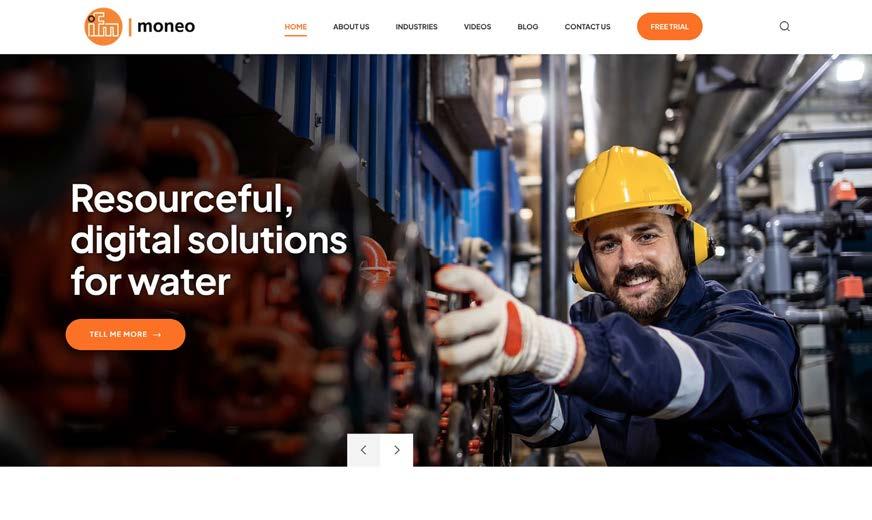
1300 365 088 sales.au@ifm.com | www.ifm.com/au moneo is a self-service, easy to use, predictive maintenance toolbox that can integrate seamlessly into your existing system. It is revolutionising operations and facilities – digitalising facilities to protect what is needed now, well into the future. ifm have combined decades of expertise in sensor technology to bring you the latest in the IIoT technology space – moneo What is moneo? How can it help your business? Need to digitalise your operation and quickly? Visit our brand-new website to discover how to enhance your business operations TODAY! moneosolutions.com.au NEW You can also register for a FREE 30 day trial!
Assessing risk with Annette
branch and the National branch of the Australian Water Association.
“THE WATER INDUSTRY found me, as opposed to me finding the water industry. I’d spent enough time working in contaminated sites and found it a bit mucky. I wanted to go somewhere cleaner and thought the water industry might be it, but my first job was in sewage.”
have planned to land in the water industry, she has been making waves since arriving. With her first job at Sydney Water as a senior consultant 25 years ago, Davison has continued to excel when it comes to having an impact on the industry.
Award-winning work
Davison and The Risk Edge Group have won so many awards that she cannot place them all on her CV. Her recognition as the Water Professional of the Year by the Australian
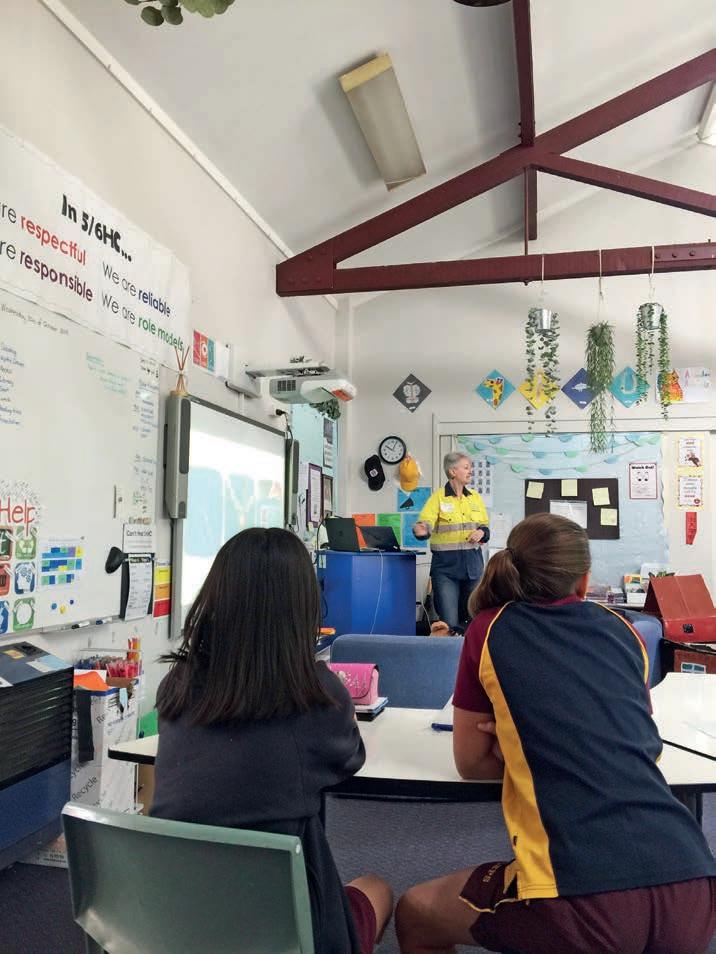
Water Association in 2021 was of particular note.
“When you know the work you are doing is important and meaningful, you shouldn’t need awards and accolades to know the value in your work, but it makes it all the more
“It’s important to acknowledge that you don’t win awards alone. You’re standing tall on the shoulders of others,” she said. “These awards are really a recognition of everyone who has helped me get to that point in my career. It recognises the strong relationships you make in the water industry because it’s more of a family. They are not just colleagues but integral parts of your life. It was also a win for my wonderful friends, my family, and of course, my gorgeous husband. Without your wider cheer squad, you don’t get to where you are, and the wins aren’t as satisfying anyway, as there’s no one to share them with.”
Risk Edge Group supporting utilities
The Risk Edge Group is a risk assessment and management company. It specialises in governance, enterprise, water cycle and resource management risk. Its staff help businesses better understand their risks, increase certainty, and meet their objectives. Such a company does not come about on its own, and Davison saw an opportunity.
“I was working in government at a time where risk was starting to rear its head as something organisations needed to be aware of,” she said.
“Our company came into being about 10 years ago. Risk Edge, as it was called at the time, was filling that gap in the market. The goal was to help utilities understand where their uncertainties lay and do something about them.”
Davison highlights the importance of knowing that risk and uncertainty are not necessarily negative. Under ISO 31000, risk is defined as the effect of uncertainty on objectives.
“If you think about it, we are all risk
18
When it comes to finding a leader in risk management and assessment, more water utilities are turning to Annette Davison. As founder and co-owner of The Risk Edge Group, she understands the challenges faced.
INDUSTRY INSIGHT Annette Davison
STEAM (science,
managers,” she said. “Every time you cross the road, get in the car, eat out, go to the hospital or make a decision, we’ve done some risk assessment and management in our heads. Water utilities are responsible for tens of thousands, if not millions, of customers. They need to understand what can go wrong with their water products and ensure that they are managed to protect those customers.”
Most importantly, understanding risk allows organisations to optimise their businesses and become more efficient. Risk management has been mandated for essential services across Australia. While there are different systems for different states, every provider needs some urban water risk management system in place. Otherwise, there can be serious penalties and consequences.
Water quality and security
When it comes to managing drinking water, scarcity is something that would rarely enter the minds of urban consumers. As far as Davison is concerned, water security is about both quantity and quality.
“You can have all the water you like, but if it’s not the right quality for your desired end use, you can’t do anything with it. Ultimately, you would have to spend a lot of money to bring it to the right level. That can get prohibitively expensive,” she said.
It’s why Davison and The Risk Edge Group offer risk workshops to utilities, local government, and other organisations. It helps those organisations understand their water quality risks and implement improved procedures.
“It could be bringing a new water source online, considering the purification of recycled water, or any number of other options,” she said. “It’s important to remember that there is a lot of work in the options

analysis space as well. That is to help organisations corral and identify potential options before assessing them against specific criteria and set objectives. Understanding the risks is vital to making informed decisions because we are looking at projects that often involve tens of millions of dollars.”
These decisions are often challenging for council-run, regional water utilities. Municipal governments usually have a range of competing objectives that can seem vast. This is where Davison and The
Risk Edge Group can step in.
“We help them review the risks associated with each objective to develop a balanced outcome,” she said. “We’ve been working with utilities across New South Wales recently to help them navigate new regulatory requirements. With the large array of legislative requirements, there is a series of things that utilities have to do. We’ve been working with a range of utilities to help ensure that their water quality requirements are properly considered.”
www.insidewater.com.au INSIDE WATER 19
Annette Davison is the founder and co-owner of The Risk Edge Group.
INDUSTRY INSIGHT Annette Davison
Future of risk management
Davison believes that utilities in Australia are mature in their understanding and attitudes to risk management. This has arisen because utilities have dealt with risks for many decades, with Australia leading the way in this space.
“In 2004, the Australian Drinking Water Guidelines were amended to introduce the concept of quality assurance rather than quality control,” she said. “It led to the development of a Framework for the Management of Drinking Water Quality based on ISO 9000 and HACCP. Instead of relying just on monitoring the water coming out of the tap at the customer’s end, utilities now look upstream along the water treatment process to check multiple different points in the system. The idea is to stop non-conforming products from ever reaching customers.”

A significant change from implementing the Framework was the introduction of critical control points — a development that came out of the food safety industry.
Davison believes the water industry has come a long way, but there is more to learn.
“One way the water industry can learn is to look at other industries.
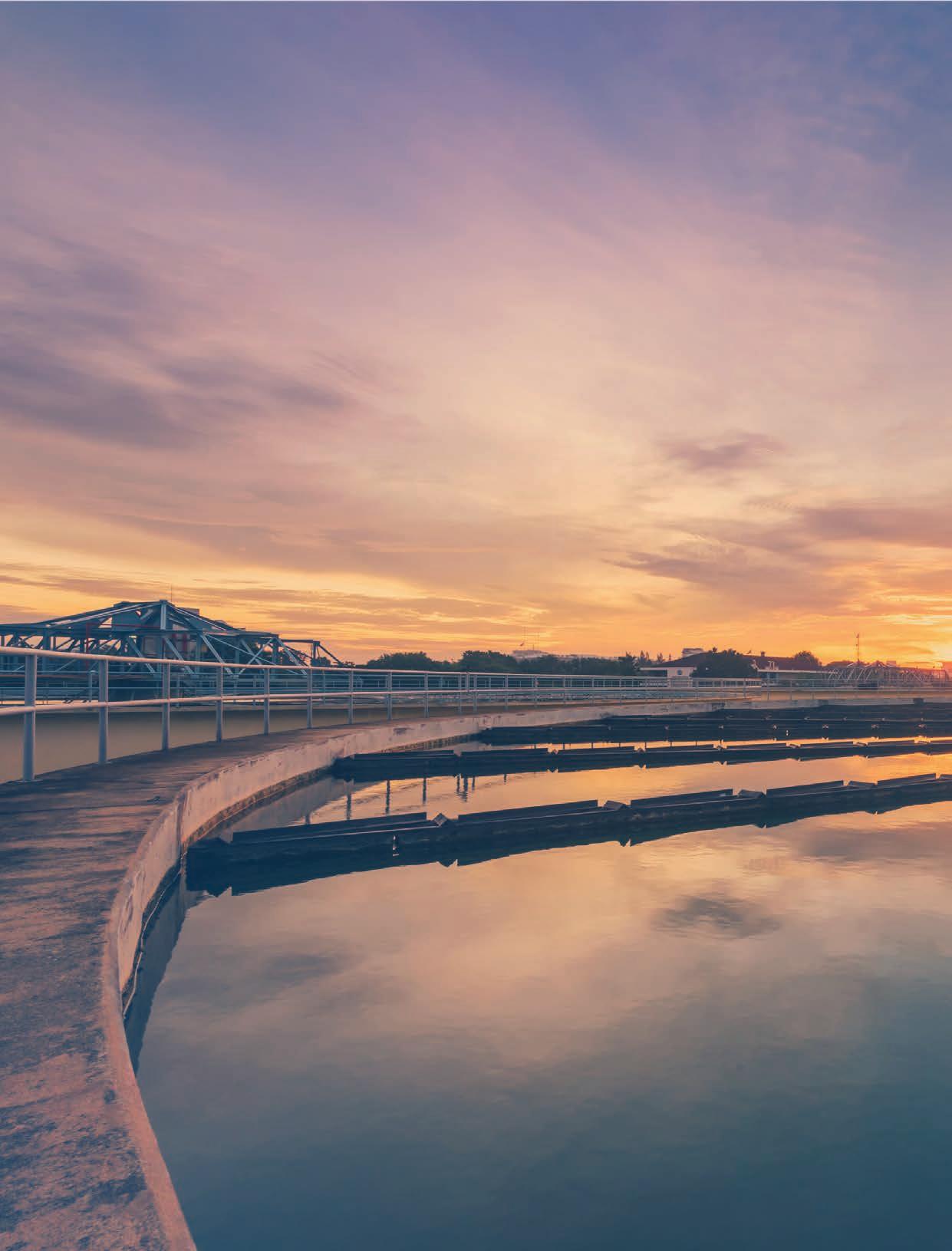
Sectors like food safety and aviation deal with risk in a range of different ways, and there are opportunities in those spaces that we can bring into our industry,” said Davison. Further down the line, Davison is passionate about working with and learning from First Nations people. She is convinced that their knowledge is integral to water management and understanding, especially including the cultural aspects and importance of water. School students are another group that Davison enjoys interacting with and whom she believes have incredible power to make changes.
“The current generation of school students is far more savvy than I was at their age,” she said. “They have access to so much more information, and influencing them will be challenging. It’s why The Risk Edge Group does a lot of pro bono education work, as part of its value of generosity.”
The importance of giving back to the community is also reflected in its OneCreek initiative, with Rotary Community Networks as a key partner. OneCreek is a grassroots initiative championed by The Risk Edge Group together with OneStreet, a not-for-profit started by Davison during COVID. It has since grown as a
rich resource for community-building. The idea behind OneCreek is to increase awareness of and care for our urban waterways, one creek at a time.
“The idea is that the local community works out what it wants for the creek,” she said. “My local creek is Rocky Creek, and it sure takes a beating. We want to give that poor creek some love and improve awareness of it as a valuable component of our environment and deserving of care and respect in its own right. Creeks can also form practical learning environments for students. For instance, students from local schools close to the creek can learn all sorts of things like hydrology, pollution, environmental science, design elements and First Nations’ importance. A natural laboratory!”
Her thinking is that if the students are genuinely aware of the entire catchment system that the creek forms part of, they will understand what happens with their dumped rubbish.
“Having awareness from an early age is key. Not only will the message stick with these students for decades, but the kids can also educate and influence their parents – well, that’s the plan!”
For more information, visit www.riskedge.com.au
20 INSIDE WATER September/October 2023
The Risk Edge Group recently won the Office and Professional Services Award at the Better Business Partnerships Award. Credit: Better Business Partnerships, photographer Gavin Little.








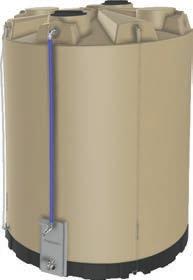

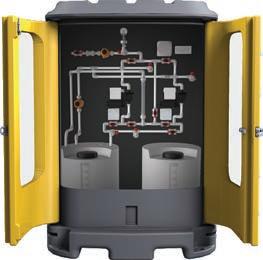





Revolutionising leachate management
Australian wastewater treatment company, Aerofloat, has been working in the leachate space for several years, making a name for itself for custom-built designs that meet the specific needs of councils and companies.

MICHAEL ANDERSON IS the general manager and one of the co-founders of Aerofloat. He’s created patented wastewater products that improve maintenance requirements, increase product efficiencies and lower costs for Australian councils and companies.
“The safe and sustainable management and treatment of industrial waste poses significant challenges to councils across Australia,” said Anderson. “Aerofloat has emerged as a pioneering force in designing cutting-edge leachate treatment plants that exemplify environmental responsibility and innovation. We have worked with several councils across Australia to manage complex wastewater, including leachate waste.”
Leachate can be contaminated and potentially hazardous, as it can contain a mixture of organic and inorganic substances, ammonia, heavy metals, and other pollutants. Leachate composition depends on the types of waste materials in the landfill, their
decomposition stage, and various environmental factors.
“Leachate is a complex mixture of dissolved contaminants that arise from the percolation of rainwater, moisture from waste materials, or other liquids through landfills and waste disposal sites,” he said. “Often referred to as “landfill juice,” it can be a highly contaminated liquid that results from this interaction of water with the decomposing waste materials in landfills.”
Managing leachate essential task
Managing leachate is a challenge for waste management facilities to prevent environmental pollution. Proper containment and treatment of leachate are essential to avoid the contamination of groundwater, surface water, and soil.
Landfills and waste disposal sites require robust systems to collect and treat leachate to minimise the environmental impact. Managing leachate waste requires a design based on understanding the leachate and its contaminants.
“Leachate can contain numerous pollutants,” said Anderson. “If not properly managed, it can infiltrate surrounding soil and groundwater, leading to widespread environmental degradation, water pollution, and health hazards.”
Shellharbour City improving systems
Shellharbour City Council contracted Aerofloat to design and construct a new leachate treatment plant for the Dunmore Recycling and Waste Disposal Depot to combat rising disposal costs. The site lacked upstream storage. As a result, the leachate quality was highly variable, with ammonia reaching 2000 milligrams per litre.
Aerofloat installed three large concrete tanks comprising an anoxic reactor, a nitrifying reactor, and its unique sequence batch reactor (AeroSBR).
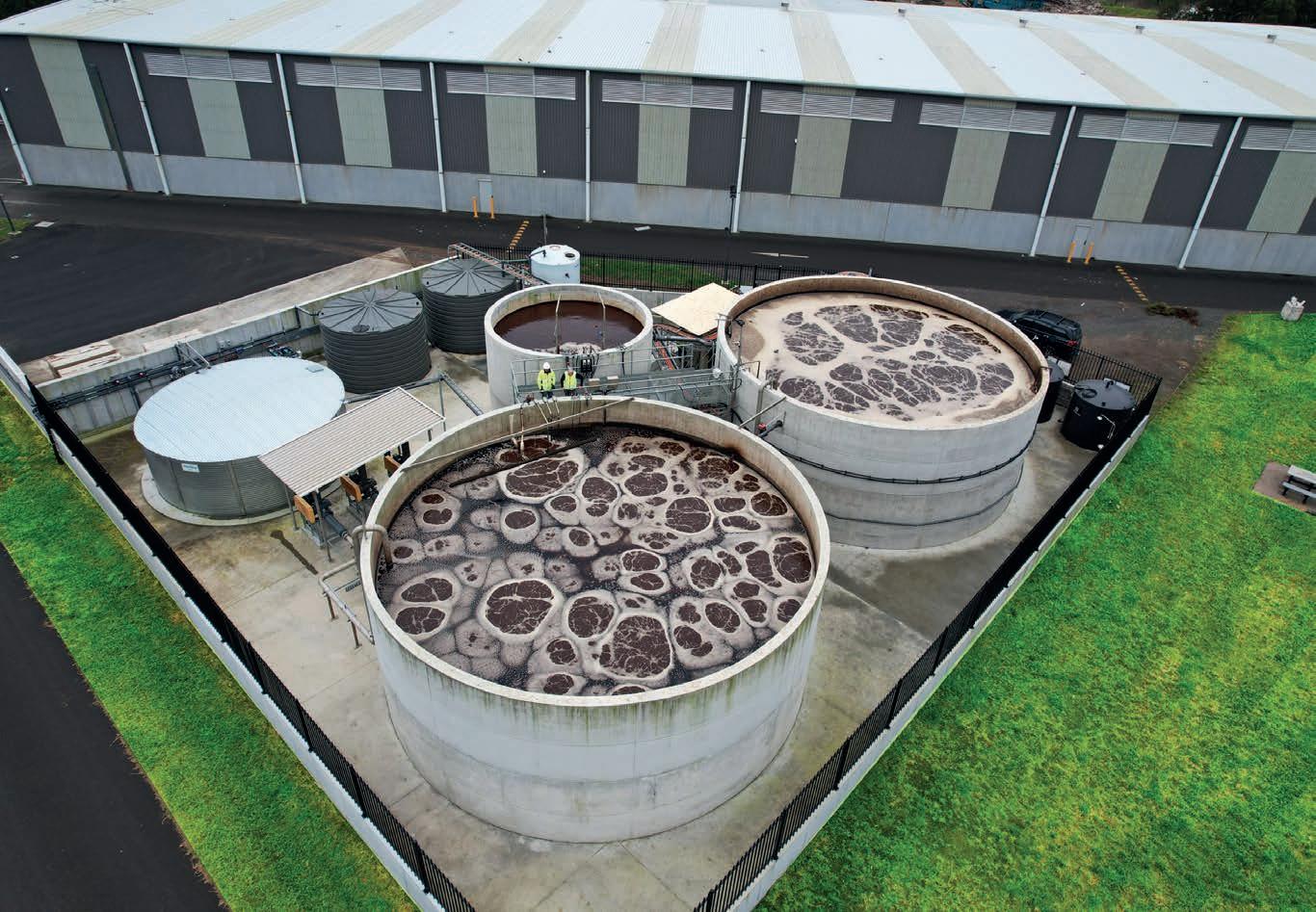
“The site at Dunmore has been operating effectively since installation well over a year ago, ensuring a sustainable solution for Council and Dunmore Recycling and Waste Disposal Depot,” said Anderson.
“To complete the build, internal recycle pumps were installed between the reactors,” he said. “Treated effluent was decanted into a tank then pumped to the sewer.”
22 INSIDE WATER September/October 2023
FOCUS Wastewater
The Dunmore Recycling and Waste Disposal Depot manages leachate more efficiently because of the Aerofloat partnership.
Chemicals are added during process phases to optimise the effluent quality and technology performance, including sucrose as a carbon source and caustic soda for pH correction. Any excess biosolids are pumped into a thickening tank for disposal by Council.
Key to any leachate treatment plant is managing the nitrification and denitrification processes to remove ammonia nitrogen from the leachate before discharge to the sewer.
“The nitrification and denitrification processes are critical in treating the leachate. Aerofloat effectively treats the high ammonia levels so that only high-quality effluent is discharged to the sewer,” said Anderson.
Kicking goals in leachate treatment
Aerofloat’s leachate treatment system for Shellharbour City Council achieves an effluent quality suitable for discharge to Sydney Water’s sewer, with a design capacity of around 65 cubic metres per day and an average ammonia concentration of 1250 milligrams per litre.


“Aerofloat critically analysed the process design from the beginning. The team leveraged its in-house knowledge and experience in treating industrial wastewater. Once the civil works and large tanks were constructed, Aerofloat made the
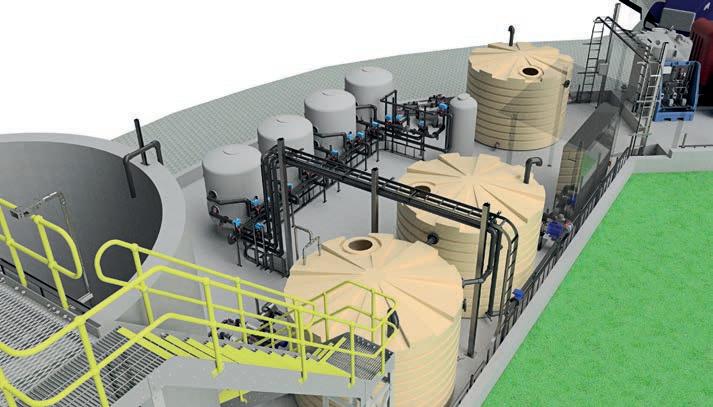
build seem simple, despite being a very complex project,” said James Brumpton, Shellharbour City Council Project Manager.
The plant was contained within a concrete bund and included a purpose-built mezzanine floor that kept all critical mechanical and electrical systems safe. An automated PLC system allows operators remote monitoring capabilities so that they have eyes on the plant even when not on site.
Aerofloat’s success for the Dunmore leachate plant was just the tip of the iceberg for moving into the leachate area. It is currently working
on multiple leachate plant builds for councils and Australian companies in Queensland and New South Wales.
“We’ve built in-house expertise, and our delivery process is unique compared to others in the market,” said Anderson. “We design our electrical control systems, circuit boards, switchboards, and automation processes in-house. It’s part of our design philosophy and unique to the industry. This remains a strength of Aerofloat, as we can provide highly customised and automated layouts for anything our customers throw at us. We also create 3D models of each project. That way, we can make any
www.insidewater.com.au INSIDE WATER 23
The Dunmore Recycling and Waste Disposal Depot provides high-quality leachate management in its custom-built facility.
A modern facility requires a comprehensive and sensible layout.
FOCUS Wastewater
“Our plant at Dunmore can manage peak loads of 2000 milligrams per litre of ammonia and can readily treat load increases of over 50 per cent. We’re currently working on similar projects in Queensland that demand a complex understanding of how to effectively treat the leachate specific to those sites.”

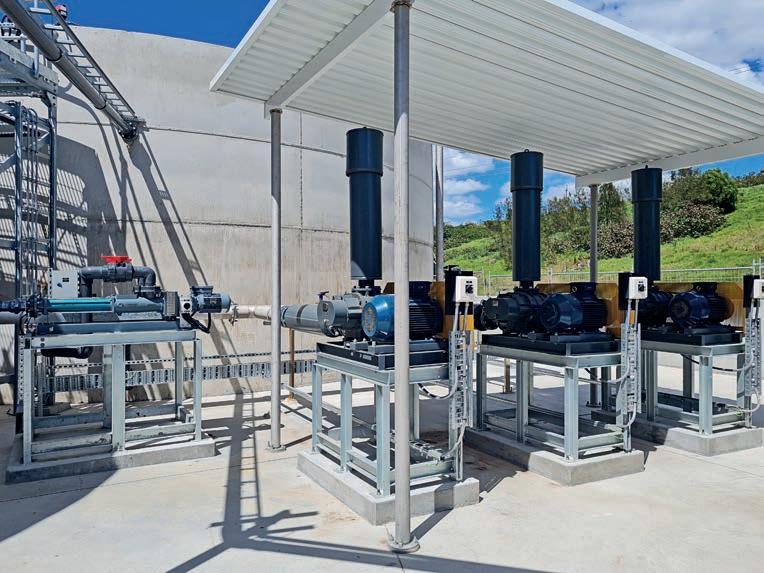
A detail-oriented approach ensures Aerofloat’s projects all achieve the same high standards.
“Aerofloat’s leachate treatment plants employ a combination of advanced treatment processes that ensure effective removal of contaminants from the leachate. Each leachate treatment scenario is unique, depending on factors such as the composition of the leachate, site-specific conditions, and regulatory requirements,” said Anderson. “Our job is to ensure that we understand the specific requirements of the regulatory authority and meet the Council or company’s mandates.”
Tailor-made for every customer Aerofloat provides tailormade solutions optimised for maximum efficiency and minimal environmental impact. It integrates energy-efficient technologies into its leachate treatment plants, reducing operational costs and lessening the overall carbon footprint of the treatment process for its clients and the community.
“Aerofloat’s designs are not only
international regulations pertaining to waste management and water quality. Non-compliance is not an option for us; our designs must ensure a sustainable, compliant result for our clients both now and long-term,” said Anderson.
This adherence to regulatory standards underscores the company’s commitment to responsible engineering and environmental stewardship. It is also known across the wastewater industry for being pioneers in innovation.
“Innovation remains at the heart of Aerofloat’s approach, and we invest in research and development to continuously improve the efficiency and effectiveness of our treatment
in place for dealing with leachate is critical.
Innovation key focus of Aerofloat
This commitment to innovation enables its engineering team to stay at the forefront of leachate treatment technology.

“Aerofloat’s leachate treatment plants are designed for long-term sustainability. By incorporating robust materials, efficient maintenance protocols, and adaptable designs, our plants contribute to the longevity of waste management infrastructure for all of Australia,” said Anderson. Aerofloat has firmly embedded itself into the industrial wastewater management sector, offering patented technology and off-the-shelf products to address a range of industrial wastewater treatment needs.
Developing customised solutions improves outcomes for
Through its advanced treatment processes, energy-efficient designs, and customised solutions, Aerofloat paves the way for a cleaner, safer environment, proving that environmental challenges can be transformed into opportunities for positive change with the right blend of expertise and innovation.
For more information, visit
24 INSIDE WATER September/October 2023


Is your pipe spacer compliant? Call us for details on ordering P (08) 9725 4678 sales@kwikzip.com www.kwikzip.com The only casing spacers successfully appraised by WSAA HDX and HDXT KWIK-ZIP’S HDX & HDXT CASING SPACERS COMPLY WITH WSAA PRODUCT SPEC #324 - CASING SPACERS; REFER WSAA PRODUCT APPRAISAL REPORT #1523
The changing face of wastewater
HYDROFLUX DIRECTOR JAMES
Hall is a chemical engineer. He’s had various roles in and around the wastewater industry, including corporate management and technical consultancy. His extensive experience and understanding of the needs of businesses across Australia, New Zealand and the Pacific means Hall and Hydroflux can help companies achieve their sustainability goals. It means he and the company can also ensure that society’s water and wastewater treatment products and solutions align with its customers’ critical needs.
“I’ve always had an affiliation with water, including Sydney Harbour and the ocean,” said Hall. “I’ve also had an engineering background of sorts. As a child, I liked to pull things apart and put them back together as a problem-solving exercise.”
As he grew up, his parents would ask him the age-old question of what he would do when he grew up. While he did not have a direct answer then, Hall decided to put a few of his passions together.
“With my interest in water and my passions for engineering and problem-solving, it was inevitable that I wound up in the wastewater industry,” he said. “I studied chemical engineering at university and always had an eye on the environment. I fell into the wastewater industry, and, fortunately, I’ve stumbled into something I love.”
Industry adapting to change

In the eyes of Hall, the most significant change he has seen is
how water is valued, specifically clean water.
“When I first started, water was just seen as something that was abundant and available,” he said.
“There was no real cost associated with water. There was a cost of water disposal, as opposed to a cost of acquiring water.”
Over the past three decades, Hall has seen the industry shift to recognising water as a valuable resource. This is not just the case for the water industry but for companies across the corporate spectrum.
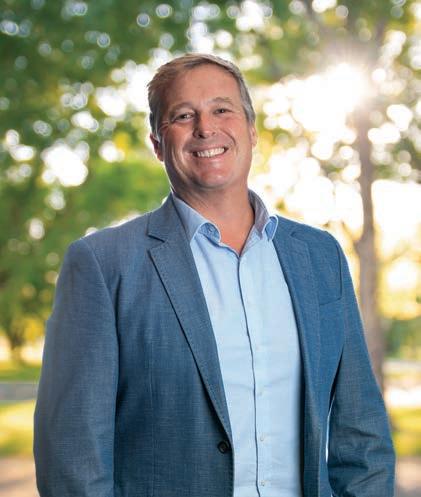
“The cost of water is now a significant part of the operations of many businesses,” said Hall. “That cost attracts attention and creates a desire to improve water use, water
treatment and wastewater disposal. To take that to the next logical step, the industry model is moving away from treating water as a cost to reduce and shifting towards treating water as a valuable resource. That treatment results in an increased value and respect for water, and that’s also occurring at the societal level.”
Hydroflux at the cutting edge
Hall reflected on the attitude at Hydroflux. He focused on how the company has taken the approach of “Why can’t we do more?”
“Early on, Hydroflux focused on recycling and reusing water,” he said. “We also looked at how to take wastewater from food production systems and turn that back into potable water. That grabbed my interest as someone who loves water, the environment, and problem-solving because it’s not that simple. Hydroflux has taken that even further as now wastewater can be converted into potable and renewable water.”
When Hall refers to renewable water, he is looking at how water can
26 INSIDE WATER September/October 2023
When James Hall gives his opinion, the wastewater industry listens. A veteran of more than 20 years in the industry, he shares his thoughts on the development and changes he has seen.
FOCUS Wastewater
James Hall is a director at Hydroflux.
be fed through a hydrogen electrolysis plant, turning it into ultra-pure water. By looking at that point, Hydroflux has fine-tuned the processes that run advanced systems.

“The other factor that has kept Hydroflux at the cutting edge is that it has become a more holistic business,” said Hall. “Hydroflux does not just look at wastewater. We are looking at where the water comes from and how we can enhance and improve it. We look at the entire water cycle, from the beginning right through to potential reuse and recycling.”
Future of the industry
Consolidating wastewater treatment plants could be the future of wastewater in Australia. Hall believes the country has room for developing wastewater treatment precincts to service large populations or multiple regional towns. He also sees Hydroflux continuing as a leader in the industry.
“There is a social accountability that is required of businesses these days,” he said. “It’s shown by action rather than words. Hydroflux is a certified carbonneutral business and advocates for water stewardship as part of its day-to-day life.“
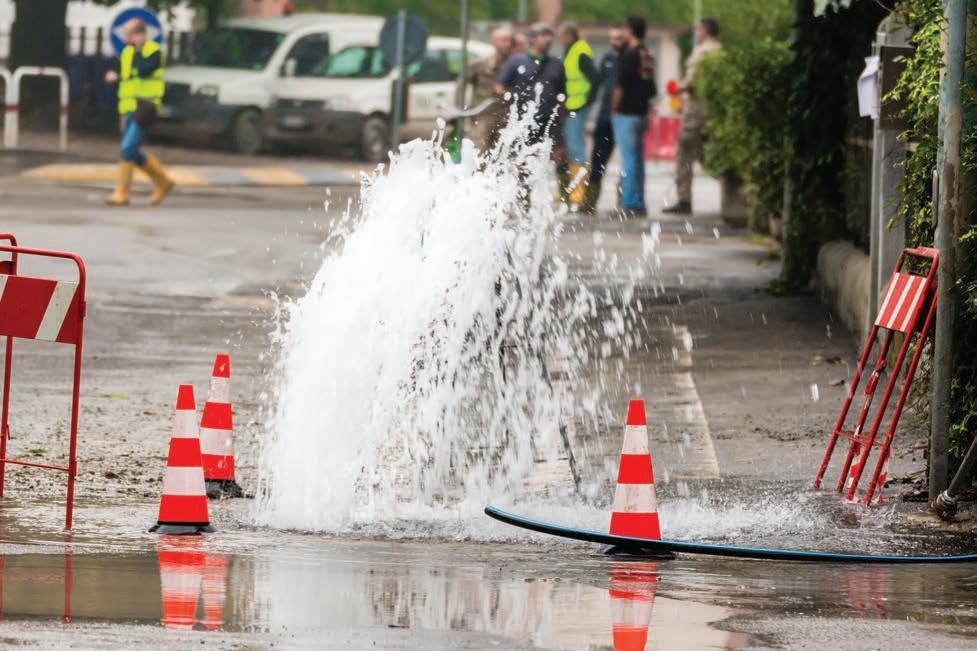
For more information, visit www.hydroflux.au
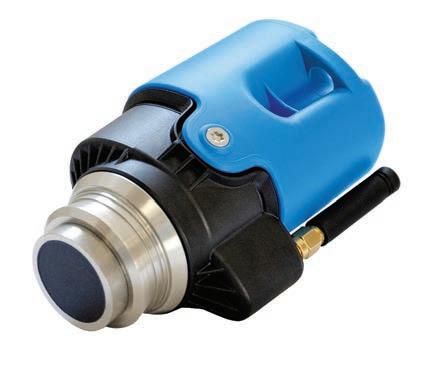
SmartEAR Acoustic IoT Logger for Water Network Leak Detection FOLLOW US ON www.watergroup.com.au water@watergroup.com.au SmartEAR-GO App for easy and fast installation Cloud Software for leak localisation, prioritisation, monitoring and alerting
Designing wastewater plants requires skill and expertise.
Understanding sensors for the wastewater industry
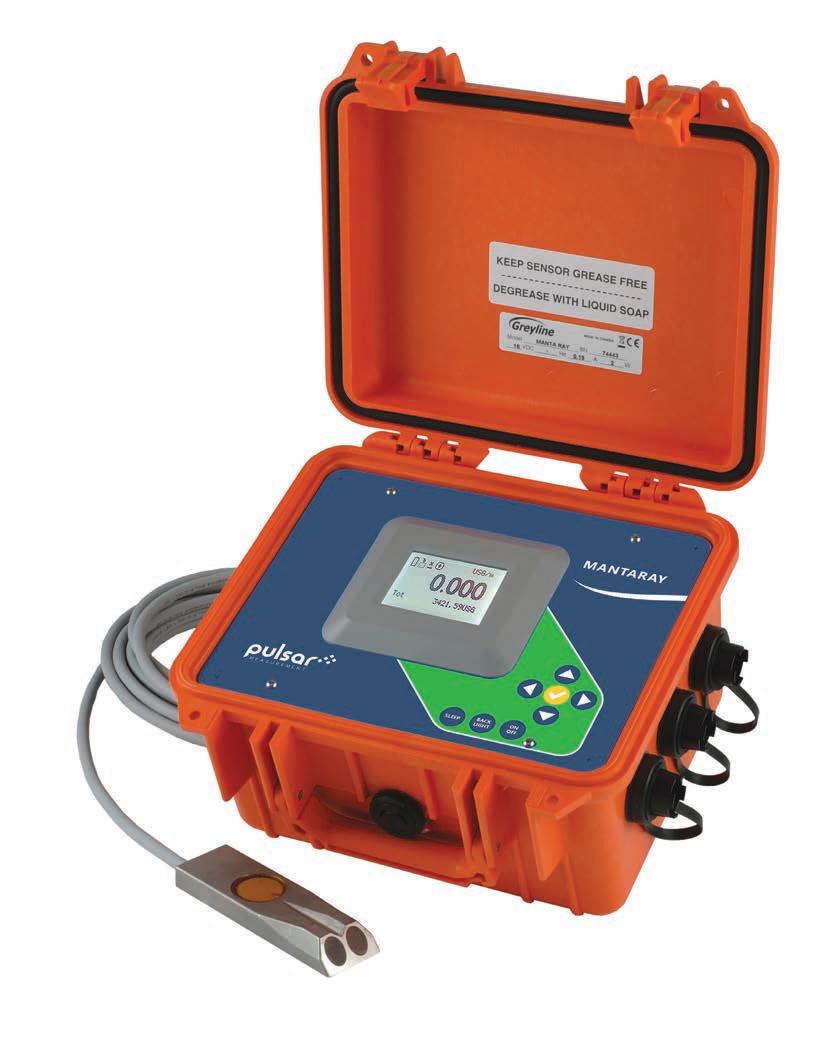
FOR EVERY JURISDICTION in Australia,
wastewater sites need to know the volume of treated wastewater travelling through their outlet pipes. No one wants poorly treated water to go into local water sources, and the fines for breaching this can reach millions of dollars. This is where Pulsar Measurement can support the industry with its technology. The AVFM 6.1, Ultra 4, and MantaRay create new opportunities for water and wastewater operators. The company’s experience in the United Kingdom is insightful, and many operators in Australia can benefit from the technology.
AVFM 6.1 – Outlet pipe measurement
Wastewater sites must know the volume of treated wastewater that goes through their outlet pipes and back into the local water source to comply with local permits and prevent prosecution for over-pumping or spills. Pulsar Measurement was asked to help find a solution to identify the amount of treated wastewater flowing through the outflow section of a client’s site. The team decided to try the AVFM 6.1 area velocity flow meter.
The AVFM 6.1 uses a submerged ultrasonic sensor to continuously measure both velocity and level in the channel. The sensor resists fouling, corrosion, and abrasion as the exposed materials on the sensor are stainless steel. The best accuracy arises when the water is not very turbulent and velocity is evenly distributed across the channel. The channel should not have drops or

direction changes immediately upstream of the sensor location. The AVFM was placed into the outlet sewer pipe on-site to measure the treated wastewater pumped. Inlet flow at the site was monitored elsewhere, and the customer controlled the pump frequencies to adjust the amount of flow that went through the application. Pulsar Measurement’s AVFM 6.1 monitored the flow travelling through the outflow pipe.
Once installed, the system performed admirably, and the readings obtained were in line with what the customer was expecting to see. End-users were satisfied with the results. Several tests were conducted to confirm that the system-reported flows, at different rates, were in line with the customer’s expectations.
family of controllers and is the first controller with an onboard localised display with trend analysis. It allows the user to get a glance at process trends over time. The unit follows a simple, easy-to-use, menu-led setup system. Installation of the unit is quick, easy, and straightforward. The on-screen trend analysis and view of echo profiles featured in the Ultra 4 unit give the user a quick and clear indication of trends over a period. The controller features embedded memory and comes with an 8GB SD memory card as standard. It allows for enhanced data logging and ensures that no historical data is lost, even if the site loses power.
28 INSIDE WATER September/October 2023
Innovative devices are transforming the wastewater industry, providing accurate and reliable solutions for efficient and sustainable wastewater management.
The ultrasonic sensor attached to the ACFM 6.1 to measure both velocity and wastewater levels.
FOCUS Wastewater
An open channel flow meter like the MantaRay can make a difference for wastewater treatment sites.
including a V-Notch weir and Parshall Flume, with two alternative options for the end-user to enter up to 32 pairs of head-toflow breakpoints.
Various communication options for the Ultra 4, including HART, Profibus, and Modbus RTU, help communication in existing site systems without expense or hassle.
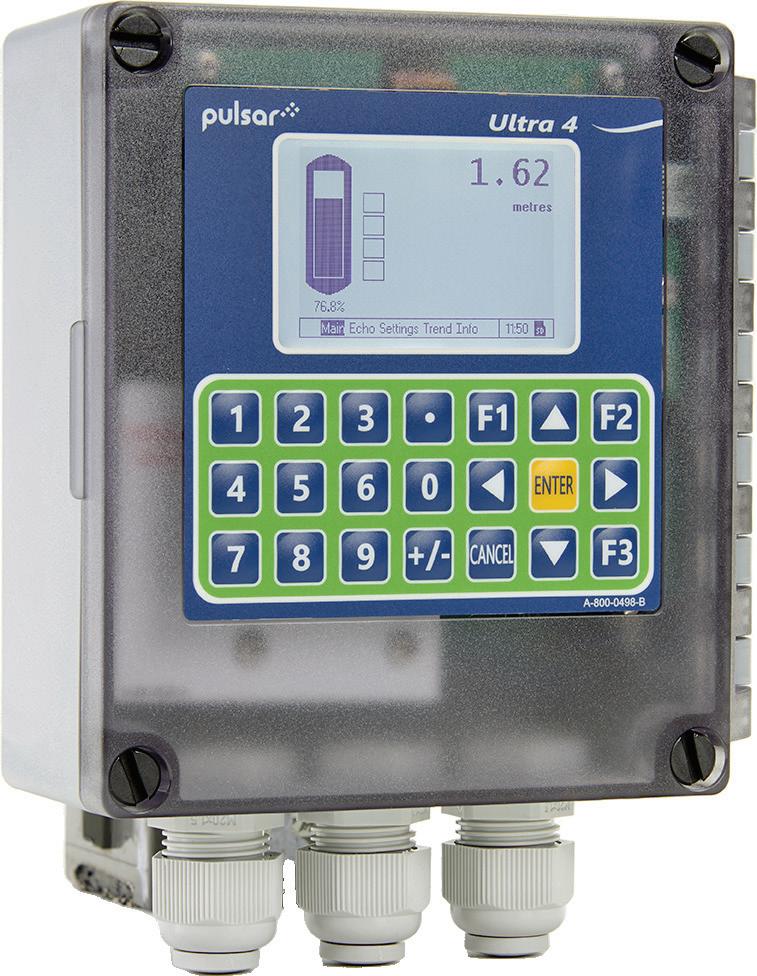
This new and improved unit’s sophistication and advanced features allow water companies to comply with the new regulations. It is a small but crucial building block in a much bigger development. The noncontact nature of the Ultra 4 and ultrasonic technology means little to no maintenance is required.
MantaRay flows the right way
An array of wastewater treatment sites are required by law to measure their environmental impact, and the discharges from any industry can vary in type. A client of Pulsar’s was concerned about the increased volume of water runoff into the surrounding environment. Together, it was decided to implement an open channel flow meter, and MantaRay was the device chosen.
The MantaRay is a portable areavelocity flow meter that measures flow using a submersible ultrasonic sensor. The unit is designed for flow surveys in open channels, partially full sewer, and surcharged pipes – making the portable flow meter suitable for sewer monitoring, industrial flow monitoring, irrigation flow, and natural streams.

The digital display, outputs, and non-essential functions are
suspended using the ‘Sleep Mode’ function to extend battery life while logging flow. Based on the logging interval, the MantaRay activates the sensor for 12 seconds to obtain flow readings and then resumes low power mode until the next logger sample interval.
The battery operation has proved to be a success for many users. This is due to the remote location of the measurement point, allowing the unit to collect the flow data required for the expansion permit. The unit’s compact size has also meant it could be installed discreetly in a cabinet on the side of a small bridge. Accurate flow data is now being recorded and logged, which ensures that data from multiple years can be stored for regulatory requirements.
For more information, visit pulsarmeasurement.com
www.insidewater.com.au INSIDE WATER 29
The Ultra 4 provides a great vision
of what is really happening.
Transforming wastewater transportation
Pumping and transporting wastewater appears to be a simple thing to do. However, the demands of wastewater transport are far from basic and challenge the best of us. Xylem sets the standard for both efficiency and reliability in transporting wastewater to treatment facilities.
“XYLEM OFFERS A comprehensive package of technology, hardware, software, algorithms, and connectors that enable utilities and local councils to immediately enhance their operational efficiency,” said Jason Morris, Xylem Australia and New Zealand (ANZ) - Product Manager for Pump Stations.
Older systems need to be replaced, and original equipment must be upgraded. Utilities are challenged to be smarter in transporting wastewater to the treatment plant. They need to squeeze more efficiency from their equipment, reduce energy use and add advanced processes. Newer pump stations must predict the future, plan for expandability and stricter environmental controls.
People like Morris are leading the charge, having joined Xylem 16 years ago and established himself in the wastewater industry.
“Much of my career has been involved in environmental monitoring,” he said.
Morris got involved in the wastewater industry through his instrumentation and process engineering background.
Making a difference
Xylem is providing innovative solutions that help utilities meet an array of issues that are helping Australian water utilities and local councils move towards better wastewater transport through well designed pump stations.
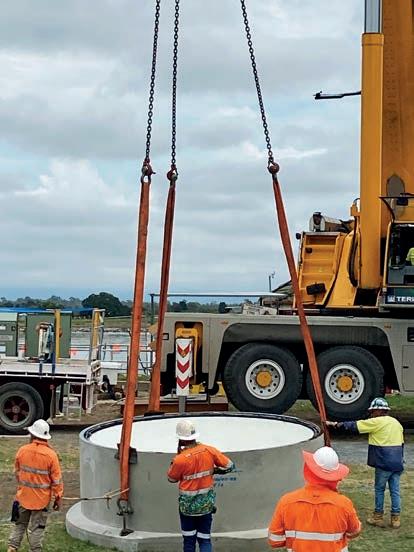
“One of the biggest challenges that
Australia faces, is such a vast area and distributed population results in network infrastructure stretched over long distances,” he said. “We are seeing small towns working harder on treating their wastewater than they did about 50 years ago.”
Xylem supports water utilities and municipal councils to improve operational efficiency, reduce energy consumption, and optimise network processes. Much of this comes from the design of the wastewater pump stations — an area that Morris focuses on.
“Most utilities are using Xylem’s FLYGT-branded pumps that work to optimise the pump stations. All the utilities want their pump stations to work efficiently and transport the wastewater fluids to the treatment plant uninterrupted. Any spill could cost large fines and substantial environmental cleanup.”
Design is key
The design of wastewater pump stations is crucial because it directly impacts the performance and reliability of the system. A welldesigned pump station reduces the likelihood of unscheduled call outs and ensures efficient and effective wastewater management.
“The last thing any operator wants is to get an unscheduled call out,” said Morris. “Calling on maintenance teams at night to attend the site to unclog a pump is highly inconvenient and uneconomical. It is why optimising the design of a pump station is critical.”
Morris explained that the bottom of the pump station should not be flat because it leads to sedimentation in the corners of the station. As sedimentation increases, it increases the risk of blockages. Even though pumps are designed to handle solids, it’s when the solids start to coagulate and clump together that big problems begin.
“Fatbergs are also a big problem for pump stations,” he said. “Breaking up fatbergs and unsettling the coagulating sedimentation in wastewater systems is the solution. We have the equipment to break up the collection of fat, oil, and wet wipes using mixers or flush valves. They can be pointed at the mass to stir the materials and put them back into suspension. The pumps can then process those materials.”
Providing safe and reliable safety systems keeps staff healthy and
Individualised, customised design Understanding what each project needs is critical to designing the
30 INSIDE WATER September/October 2023
FOCUS Wastewater
importance of examining the issues that are happening on-site.
“Every site is unique, and the site’s situation relative to other factors can reflect the number of solutions that Xylem implements,” he said. “For example, if we know that there’s going to be a lot of fat and oil in the wastewater, we can put those specific solutions in place. “Greenfield sites have different challenges, as we need to flush the pump station regularly. It’s important to bring the flow up to scouring velocity. This minimum velocity is required to keep the solid particles in suspension with water, and particles keep moving with water.”
He also pointed to the importance of having pumps that can detect blockages themselves, such as the FLYGT CONCERTOR range that can spin backwards to remove blockages and have another go at processing the materials. Morris stressed that Xylem has a range of different solutions for different situations.
“We ask customers about the problems they are facing. Once the client starts talking about the specific problems they want to solve, Xylem can help by offering a range of solutions to improve the efficiency of the pump stations,” he said.

Algorithms and software
Xylem‘s FLYGT SECAD software supports the optimal design of pump stations. It utilises advanced engineering techniques and data analysis. FLYGT SECAD considers factors such as hydraulic requirements, site conditions, and specific project needs. It helps the company generate tailored and efficient pump station designs. The software also helps reduce operational issues, maximise performance, and enhance overall wastewater management by optimising the design process.
design,” said Morris. “It leverages the experience and expertise of Flygt to design pump stations that are robust and optimised for efficiency. This results in enhanced performance, reduced downtime, and improved overall operational effectiveness.”
“We do a lot of 3D modelling to understand how the pump stations would work,” Morris said. “We can show where the inlets are going to be, how the valve chamber is going to be set up, and where some of the accessories for the valve chamber can be installed.”
The wastewater network flow can be monitored and optimised using a digital twin, Xylem Vue Powered by GoAigua platform. This can iron out peaks and troughs in the flow to the treatment plant. It is a significant part of the digital transformation that water utilities are working on. The algorithms used in Flygt pumps help achieve high-quality pump operations. These algorithms enable functions like unblocking, cleaning, and energy optimisation. Each algorithm contributes to the pump system’s reliability, efficiency, and performance.
Xylem’s data scientists have been working hard on algorithms that optimise not just products but the entire network operation. Eventually, AI will optimise those algorithms even further. “Digital twins allow utilities to develop a digital equivalent, or twin, of their assets in the field,” he said. “It allows utilities to experiment with different asset settings under the
algorithms will support water utilities as they digitise their entire network.”
Supporting sustainability and net zero
Net zero and being sustainable can be challenging for wastewater pump stations. Given that they must be on much of the time, pump stations tend to consume significant amounts of power.
“Optimising the pump duty point means that Xylem can help utilities optimise their energy consumption,” said Morris. “If we’re pumping into a network that has some semi-closed valves, the algorithms will indicate excessive energy consumption. It allows utilities to find the problem and solve it.”
By providing advanced water and wastewater treatment technologies, Xylem enables utilities to improve energy efficiency, reduce water consumption, and optimise process performance. Its data-driven solutions and digitisation facilitate the identification of areas for improvement. Utilities can implement predictive maintenance strategies and optimise operations. These efforts contribute to net zero goals by minimising environmental impact and maximising resource utilisation. “Solving water challenges is what we do best at Xylem. Our technology helps utilities and local government to optimise their wastewater systems,” said Morris.
For more information, visit www.xylem.com/au.
www.insidewater.com.au INSIDE WATER 31
with time and innovative due to companies like Xylem.
Polymaster providing proper solutions
Storing wastewater and other hazardous chemicals is not a market opportunity for the faint of heart. Getting it wrong can cost millions in fines, not to mention a loss of reputation. Polymaster is setting the standard.
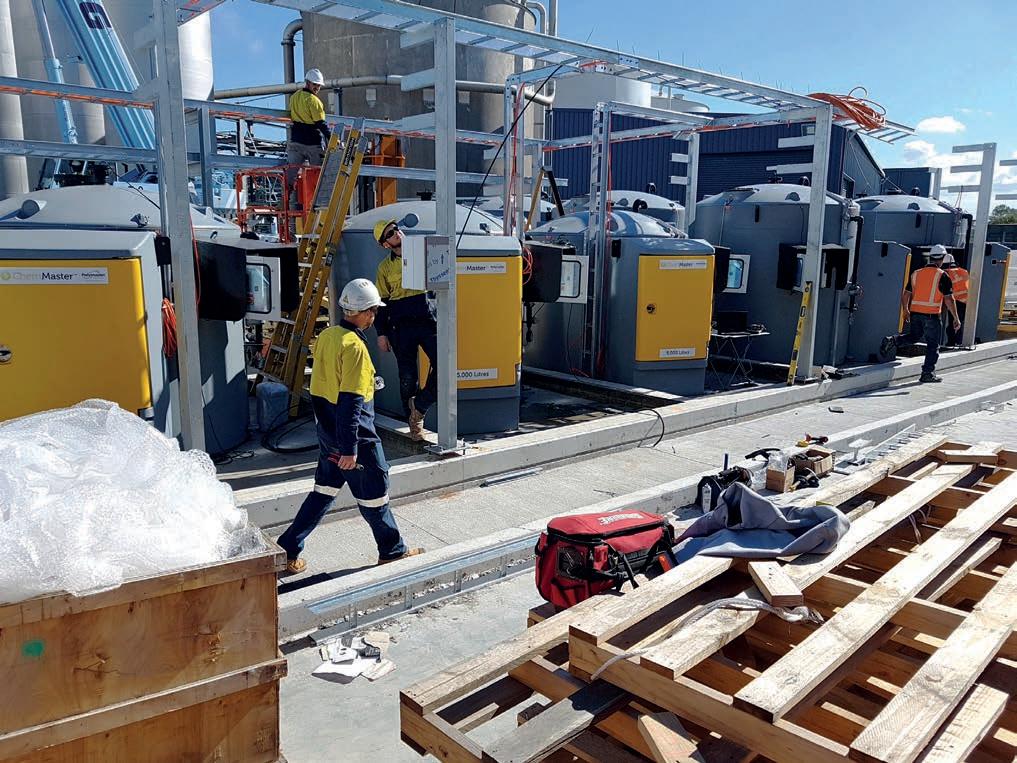
“WE DON’T SEE a huge range of chemicals in the water industry, as opposed to the wastewater industry. We build our tanks out of material that will be inert to the chemicals.”
That’s Jason Egan, the National Key Account Manager for Polymaster. Polymaster is an Australian manufacturer of liquid storage solutions. The family-owned national business has offices and facilities throughout Australia, and its vision is to become the industry standard for liquid storage.
Egan has been with Polymaster for about four years. He came to the industry after years in rail and logistics.
“Polymaster is a good business. It’s growing and knows what it will do and where it will expand. Its progress and growth combine well with the people and the culture. Our staff
turnover tends to be low, so I’m happy to be here,” he said.
Polymaster has been at the forefront of the industry for almost three decades. Its success comes from designing and manufacturing industry-endorsed and productcertified solutions. Its products include chemical tanks, diesel storage, rainwater tanks, liquid fertiliser storage, septic tanks, and animal care products. Polymaster has built its reputation on innovative designs, good customer service, and commitment to delivering quality products.
At the cutting-edge of liquid storage Polymaster’s commitment to innovation is reflected in the range of materials used to create its tanks. Its quality promise means users will
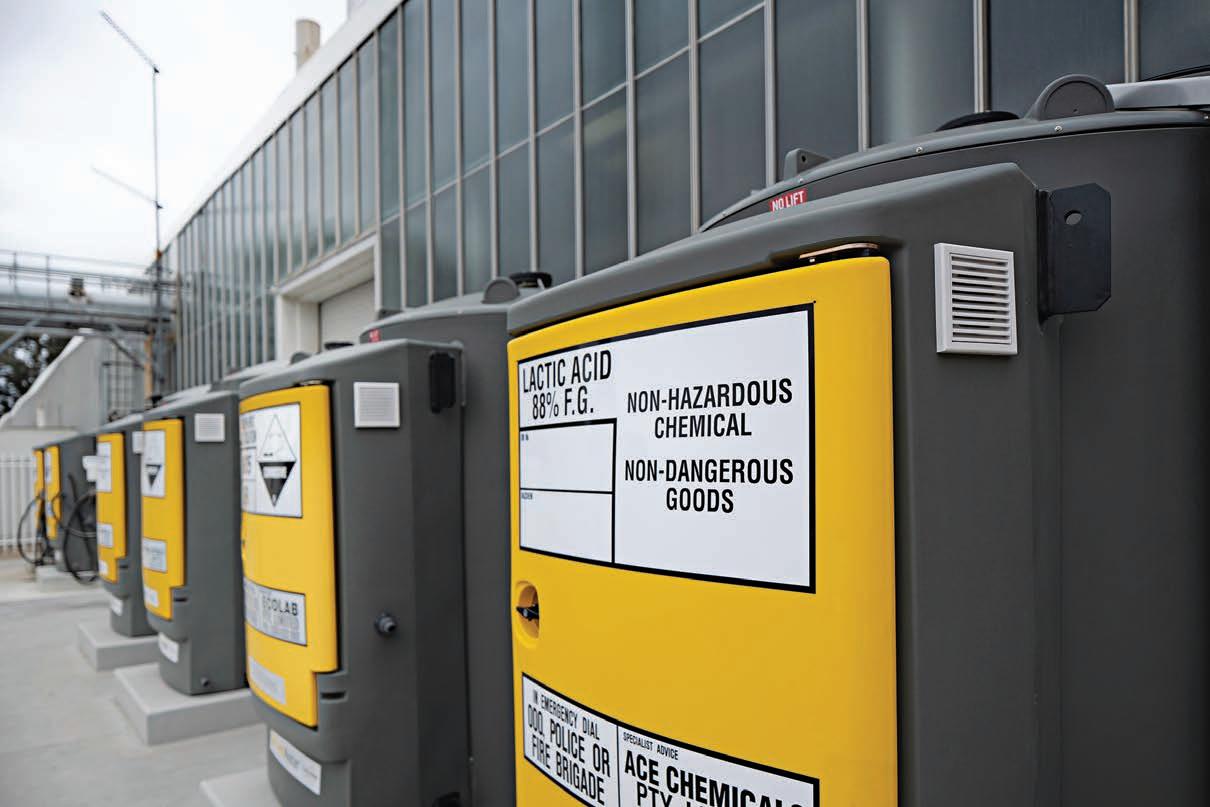
get products that will last. It is what Polymaster has built its products, reputation, and entire business around. Top-grade materials are fundamental to its products that are trialled and tested at every point in the design and manufacturing process. Every tank is backed up with global quality and process certifications.
“The big difference we have is that Polymaster has its grades of chemical material,” said Egan. “We have a sister business of the company, which produces raw materials for our tanks. The team add antioxidants to achieve different grades of chemical compatibility. It means we offer specific tanks that will hold specific chemicals. When engineers look for a storage tank, they can be sure that Polymaster can offer a compatible tank. They do not need to work out if the tank is compatible, the right size, and in line with the relevant standards. If an engineer wants a sodium hypochlorite tank, we can provide one.”
It’s not just the materials that keep Polymaster at the forefront of such technology. Including dosing equipment as part of the construction benefits customers. All the products can be included in the cabinet for dosing equipment.
“We can install the pump, pipe works, and other elements
32 INSIDE WATER September/October 2023
FOCUS Wastewater
The Enclosed IBC Bund tanks are designed for any industrial wastewater user.
internally,” he said. “It allows our customers to accurately dose the chemicals needed for the relevant purpose. This is critical for those working in the food and beverage industry or water treatment. No one wants to be responsible for the destruction of the final product. When it comes to water treatment, the disposal of improperly treated water into waterways can result in significant fines.”
Involved in major projects
Polymaster has been involved in many projects across Australia. Some of its key work is around soil remediation.
“We are working with almost every major road and rail project across Australia,” Egan said. “You can see the cone-bottom tanks on those sites. They are designed to encourage the sludge to sink to the bottom, almost as part of a pre-filter process. We can hook them up to pipes and backwash tanks on site, so we call them plug and play.”
Once the tanks are full of liquid, coagulant flocculants can be added to ensure the sludge sinks to the bottom. The next process is usually filtration. Polymaster also helps clients complete their pH corrections.
“When it comes to trade waste from various industries, it largely
works the same way, finishing with pH correction,” he said. “The water utilities require us to have the pH of the water within a very specific range, and significant fines kick in if the client can’t meet that. It’s why there is a meter for tracking the pH level.”
Proud of continual innovations
Egan spoke about the innovation behind the company. He is most proud of the self-bunded chemical tanks. They are double-walled, and the self-bunding means that Polymaster has effectively manufactured a tank within a tank. The smaller internal tank is constructed inside a second purpose-built polyethylene tank. It’s designed to prevent chemicals from interacting with the environment in the unlikely event of a leak.
While Polymaster is also proud of its integrated dosing systems, Egan spoke about one of the top-selling new products.
“One thing attracting a lot of attention is our unique Enclosed IBC Bund. It solves many problems
associated with IBC storage and chemical/fluid decanting in a weather-resistant, purpose-built enclosure,” he said. “Polymaster makes it from high-grade polyethylene material. The enclosed IBC Bund allows easy forklift movement with a simple connection to a 250-litre day tank. It eliminates OH&S issues associated with IBC handling. We developed this product with some of our biggest customers, so their engagement in the process was vital.”
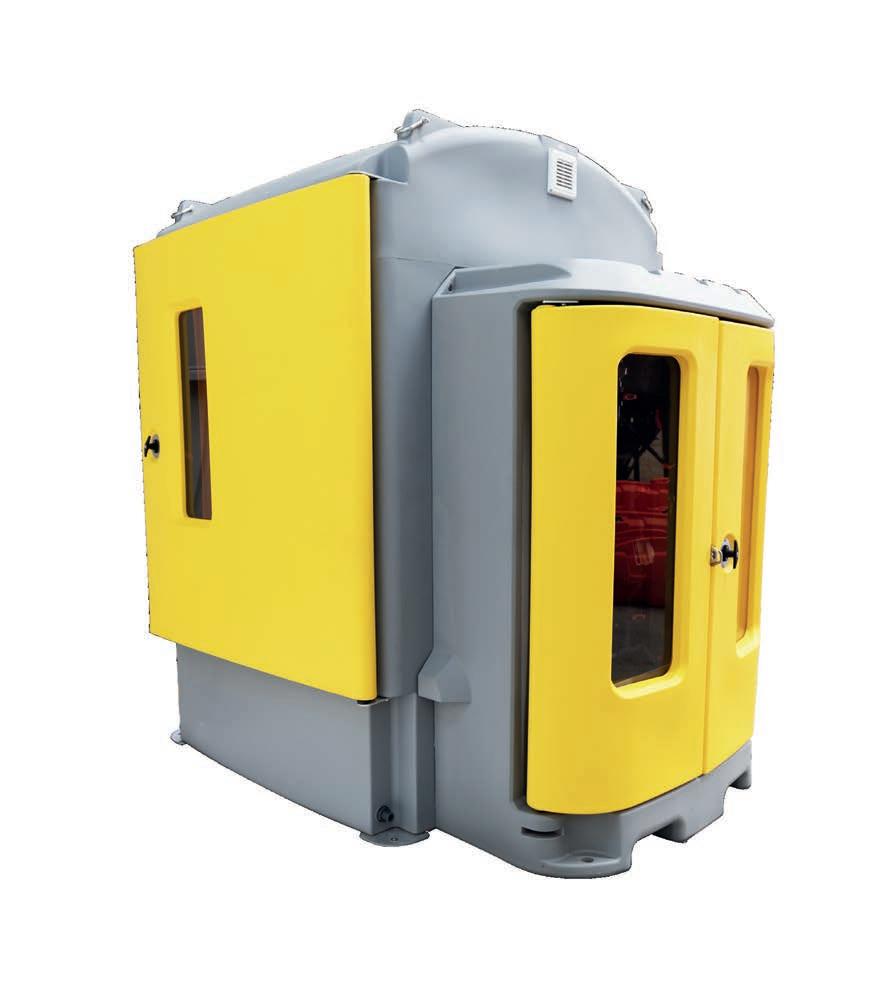

The innovation is part of Polymaster’s acceptance in the marketplace. Their continued focus on research and development has shown customers that Polymaster is at the cutting edge of liquid storage.
“We’re adding pH and chlorine analysers that are now standard for dosing systems. It gives customers reportability and transparency, supporting their environmental and sustainability goals.”
For more information, visit www.polymaster.com.au
www.insidewater.com.au INSIDE WATER 33
Having the right tanks for the right chemicals is an essential part of the Polymaster customer experience.
Merewether upgrade for merry weather
In the beachside suburb of Merewether, Newcastle lies the Merewether Emergency Relief Structure (ERS). After years of environmental impact and weathering, Interflow came in to repair the pipe.
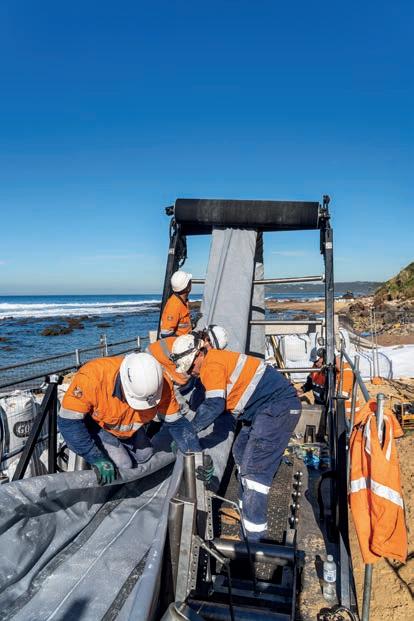
THE MEREWETHER EMERGENCY
Relief Structure (ERS) relieves major sewer networks during wet weather events or failure of the Burwood Waste Water Treatment Works (WWTW). The non-circular (ovoid) pipeline extends from an access hole adjacent to the baths all the way out past the beach to the nearby rock shelf.
In 2011, a failure of the WWTW activated the ERS, which was unable to perform as needed because of high tide and blockages. The result was uncontrolled discharge from access chambers along the foreshore. This resulted in the closure of Merewether Ocean Baths.
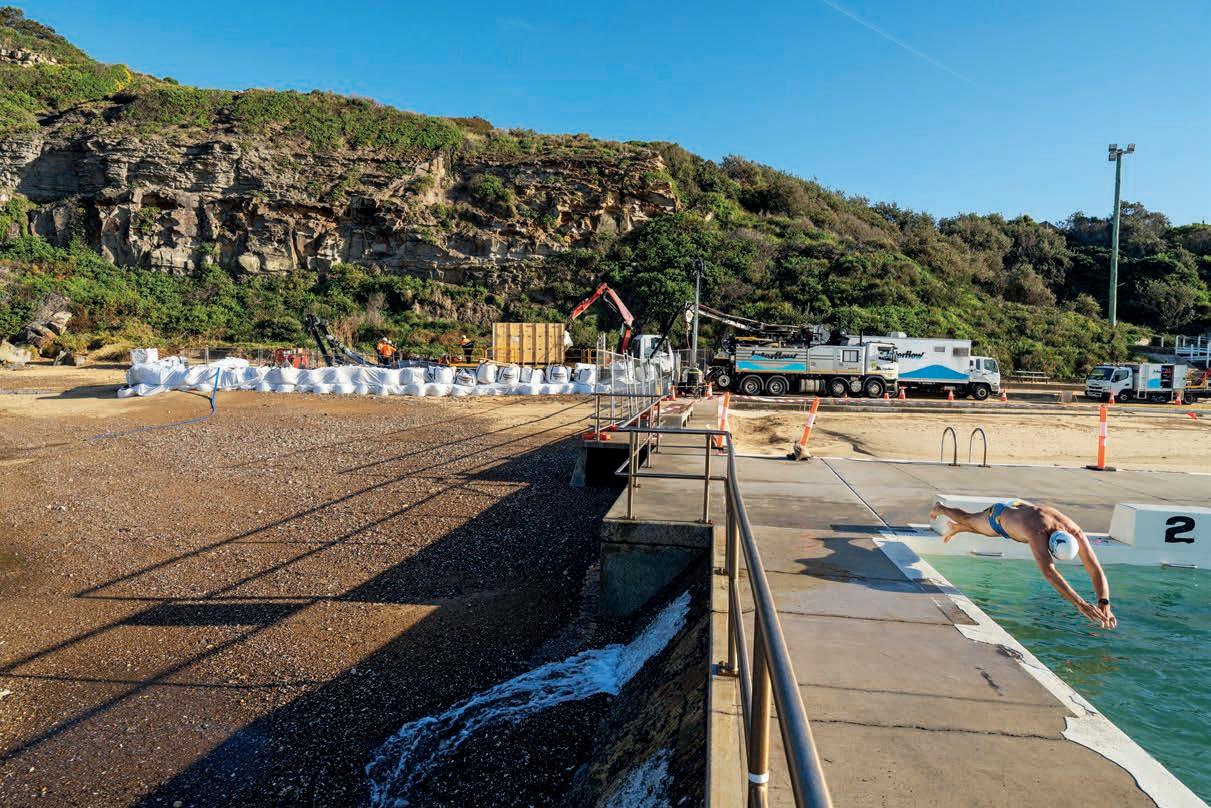
After this event, Interflow was engaged to reline a 90 metre section between two access holes. As part of their inspection, CCTV revealed that the downstream areas of the pipe were in poor condition. They also found cracks along the pipe wall, allowing sand in. This was exacerbated by the shape, slope, and lack of a non-return valve, meaning sand accumulation within the pipe was inevitable.
Allan Moran, Hunter Region Project Manager for Interflow, reflected on the project.
“This pipe was originally installed in the 1900s, and we were asked to reline a 90 metre section after 2011. This section extended past the ocean baths, and it turned out that the pipe had a lot of sand in it. It was about 50 per cent full of sand when we got there,” he said.
Initial goals and challenges
The project’s primary objective was to reduce sand infiltration into the overflow system by relining an additional 130 metre section of the pipeline. This concept seemed simple enough in theory, but the unique site conditions saw the project team take on the ocean itself to safely deliver the relining works.
“When we went back in 2022, we found that the pipe had anywhere from 600 to 700 millimetres of sand along much of its length. That filled half the pipe, which meant we had to remove tons of sand,” said Moran.
At high tide, the pipe was about a
metre below the surface. This meant Moran and the team needed to find a way to isolate the pipe from the tide. This was not just to reline the pipe but to clean and prepare the pipe for the lining.
“One of the biggest challenges was removing over 50 tons of sand from the pipe,” he said. “While that sounds
34 INSIDE WATER September/October 2023
FOCUS Wastewater
Another critical aspect for Moran was keeping the team safe. Being so close to the ocean, there were questions about how to keep the people inside the pipeline safe in the event of freak weather events or the unlikely chance of a wastewater treatment plant (WWTP) failure.
“We had to cover many safety issues before we even started,” Moran said. “In most situations, we experience fluids coming downstream from further up the pipe. In this case, we were worried about fluids coming up from the end of the pipe (downstream) and fluids coming down the pipe. We had to spend a lot of time thinking about things like overtop waves.”
Keeping that water out required introducing a massive bulk bag sea wall made of over 100 tons of sand. Interflow also had two separate pumps for pumping seawater out of the system. Running these pumps non-stop meant that infiltration rates were brought down to nearly zero.
Interflow’s unique technology
Interflow used its ultraviolet curedin-place pipe (UV CIPP) solution from its Interline range. It is a trenchless, structural lining method that uses ultraviolet light to cure the liner once it is inside the pipe. Its flexible design was perfect for the ovoid pipe.
would spend a week sealing the pipe,” he said. “However, a massive storm came through that weekend and dumped between 20 and 30 tons of sand. We had to clean it all up and then put the seawall up. It took us two weeks to clean and seal the pipe.”
Just 48 hours before the liner was due to be installed, a second freak storm created more problems for Interflow and the team, with three to four-metre waves hitting the beach.
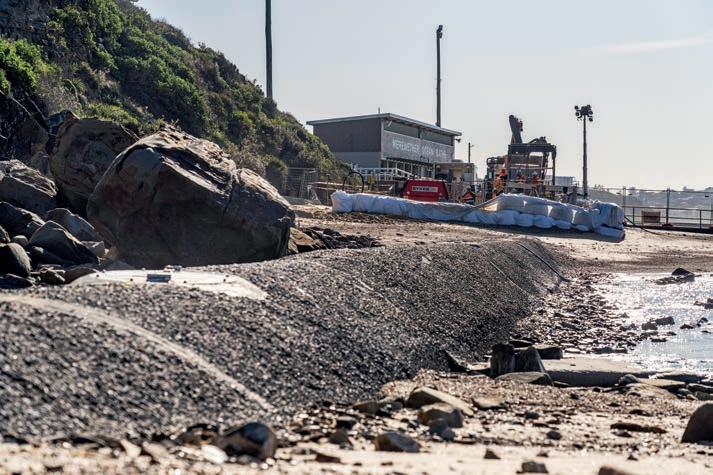
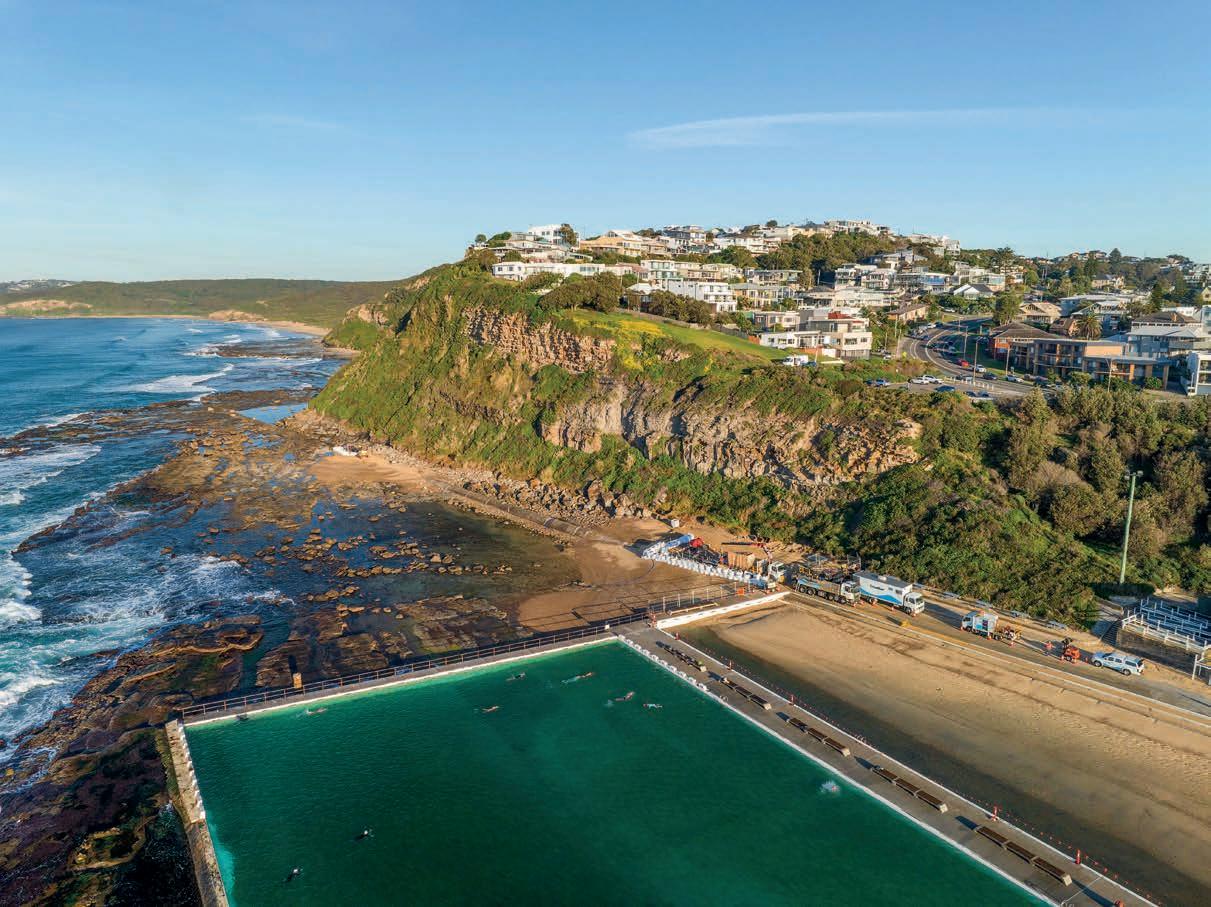
“We had to go and clean the entire pipe again. We lost the Sunday and Monday to rebuild the seawall,” said Moran. “Extra crews had to come in to clean the pipe, which took a solid 24 hours. We started pulling the liner through the pipe on the Tuesday night. The team needed a perfect period of three to four days with really low tides, no wind, and not much else to impact the lining of the pipe.”
Newcastle on Friday, so the entire job had to be completed before the storm came through.
“Because of the storm on the Sunday night, it pushed that whole process back,” Moran said. “It meant that we were cutting on Wednesday. On Thursday, we then had to pump concrete in and have everything packed up ahead of the Friday morning storm. Just having a liner in was the best thing ever.”
In the eyes of Moran, this was mostly a typical project, but in an exceptional environment.
“In the end, we were successful because our people were so resilient. They had the right skills, of course, but it was their ability to adapt and keep going in the face of so many setbacks that got us through.”
For more information, visit www.interflow.com.au
www.insidewater.com.au INSIDE WATER 35
picturesque Merewether Beach.
NT water planning on track
The National Water Initiative (NWI) is the nation’s blueprint for water reform, adopted by all states and territories in 2004. The Northern Territory (NT) has taken steps to implement all aspects of the NWI.
THE NATIONAL WATER Initiative (NWI) is Australia’s blueprint for water reform. It was adopted by all states and territories in 2004. The NWI sets the overarching framework and outlines fundamental principles to support jurisdictions as they transition to sustainable water resource management.
One pillar of the NWI requires jurisdictions to develop and implement water plans. Since 2004, the Northern Territory (NT) has taken steps towards implementing every aspect of the NWI. That includes through its regulatory and planning activities.
Despite the work that has been done, the NT government has been
achieving the outcomes of the initiative.
Submissions to the inquiry highlighted a lack of trust in the NT Government to implement the NWI and ultimately sustainably manage the NT’s water resources. This has been further reflected and amplified by news articles in the mainstream media, including in other states and territories across the country. Those articles do not refer to or seek to understand the Territory’s context. They do not account for the deliberate flexibility provided within the NWI agreement. This flexibility is designed to reflect the disparity of jurisdictional contexts.
water planning. Badu is an independent agency external to the NT government. It specialises in water management and provides strategic advice to the government across all levels. The scope of the review included an assessment of whether the NT was meeting its NWI obligations and an evaluation of the relevance of each NWI objective considering the NT’s environmental, social, and economic context.
The review found that the NT’s water planning processes are fit for purpose and consistent with the flexible approach within the NWI.
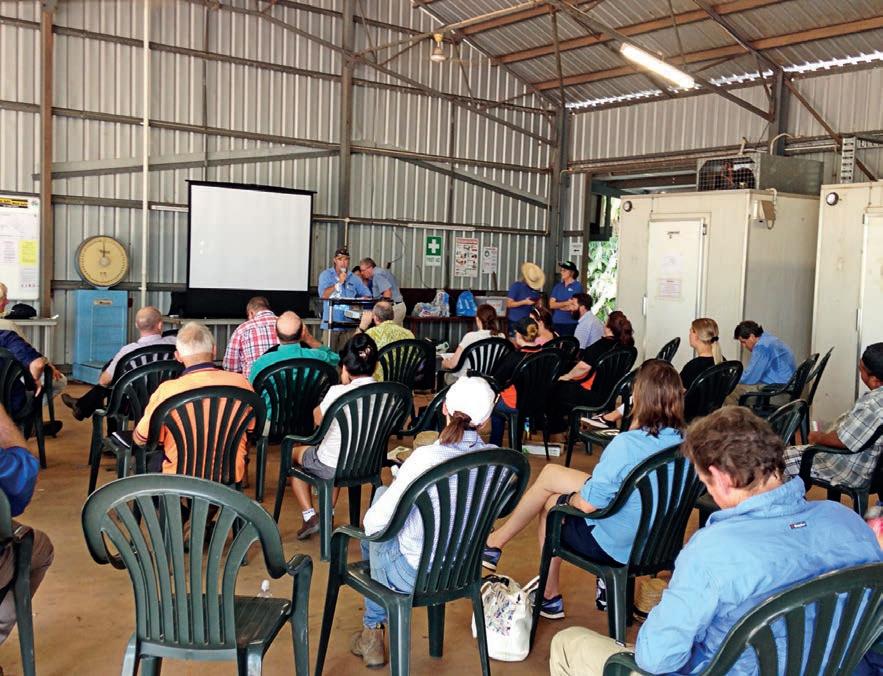
The review identified the Territory’s unique context as a strength and a challenge. It considered the current state of its water resources a strength, but the NT’s ability to implement NWI requirements was viewed as a challenge.
The Territory context identified in the report is defined by a developing economy, a small and diverse population spread over a wide geographical area, unique land tenure arrangements, underutilised resources, and water’s high environmental and cultural value.
Water planning processes working well
In terms of water planning, the review found that water planning processes in the NT seek to balance the social, economic, and environmental values. Badu found that stakeholder engagement and the planning processes give due consideration to those values. Each plan is put together to uniquely align with the varying water resource contexts across the NT.
Furthermore, statutory water allocation plans are being developed. Those plans focus on areas with emerging demand and the most competition for groundwater use. NT-wide policies and procedures are
FOCUS Water Management
being used to guide decision-making outside those areas.
Several criticisms of the Territory’s water management relate to the minimal geographical area over which plans are declared. The Productivity Commission noted that of all jurisdictions, the NT has the lowest proportion of licences granted within a water plan area.


However, NWI allows jurisdictions to determine “whether a plan is to be prepared… based on an assessment of the level of development of the water resource, and projected future… risks”.
The development of water allocation plans continues to expand the areas covered by the NWI. The policy is being developed that guides decision-making outside plan areas.
Five water allocation plans across the Territory are currently declared and under development for the Georgina Wiso, Western Davenport, and Mataranka regions.
Most recently, the department has developed the Surface Water Take–Wet Season Flows policy. The policy will support precautionary decision-making on applications for water extraction licences to take surface water during the wet season and ensure extraction is undertaken sustainably.
Aboriginal Water Reserves are established alongside water allocation plans
An Aboriginal Water Reserve was established through legislation. It covers a volume of water from a water resource that underlies Aboriginal Land to be set aside for Aboriginal economic development. The NT is set to lead the nation in this area with over 60,000 megalitres per year of water set aside for Aboriginal people in the three draft plans to be declared later in 2023.
The review noted that the NT government could improve its
engagement and environmental management processes. While the government is meeting the NWI’s 12-month engagement ‘rule of thumb’, the review noted that meaningful input, particularly into the cultural values of an area, is likely to take much longer. The review also noted that most of the government’s challenges are mainly centred around the population’s small, remote, and widely dispersed nature. Collaborating with multiple Aboriginal groups across each area is also a challenge. It also identified precautionary decisionmaking and the implications of using groundwater storage as areas for further work. In this way, the NT government can ensure future compliance with the NWI principles. The NT applies policy-based rules in areas outside of a plan when assessing licence applications. The review stated that consideration should be given to amending the policy-based regulations to be more specific to balance the groundwater storage availability with a continuous demand for water, such as for public water supply.
The review also notes that environmental management within or outside the formal water planning process will remain a challenge because of the more limited resources of a smaller jurisdiction, the distances involved and the need to identify groundwater-dependent ecosystems and their susceptibility to lowered water levels, which is a developing science.
Newcastle Waters is a critical resource for animals and birds. The Elsey National Park has water resources that need to be looked after.
In summary, the NT is consistent with the NWI. While there are areas for improvement, the Northern Territory’s challenges are unique. However, the NT’s government says its commitment to the NWI will ensure that the importance placed on water in the North continues to reflect its social, cultural, economic, and environmental significance to each and every Territorian.
For more information, visit nt.gov.au/environment/water
www.insidewater.com.au INSIDE WATER 37
Sailing the seas of safety and wellbeing
Increased focus on mental health
THE WATER INDUSTRY can be a challenging one to work in. It’s not just about the long hours or weekend shifts. It can be the sudden requirement to jump out of bed to deal with an emergency. Sometimes, it’s being in a rapid-response team for an extended period. These are just a few situations where staff members can feel burnt out.
It’s why SUEZ is studying and spending time ensuring that its people have the equipment and training they need to do their jobs well. It’s also about looking after their physical and mental wellbeing, as well as their work-life balance.
This is why flexible work and training go hand-in-hand with improved employee wellbeing. At SUEZ, teams can look at different methods for improving the wellbeing of their employees, depending on what works best for each employee and team.
How people are supported
Nichole Perry is the Head of Safety and Wellbeing at SUEZ Australia and New Zealand (SUEZ ANZ). She takes her role seriously, having worked previously in high-pressure industries such as oil and gas.

“Health and Safety (H&S) has changed from being more ‘policing’ and paper checklist on clipboards to becoming more engaging and visible with all workers (and with no paper),” she said.
“H&S is about having those conversations with workers, discussing choices made in risk management, work setup and understanding why people choose what they do. This is the ever-

evolving change I have seen in over 20 years as a H&S professional.”

Perry explained that SUEZ aims to improve the work-life balance of all workers. To do this, SUEZ created a working group with members from all SUEZ contracts in Australia. This working group is tasked with developing wellbeing policies and programs to improve workplace mental health for SUEZ across all levels of the organisation Similarly, Chris Melville is the Head of Information Technology (IT).
“SUEZ has always promoted the physical health of its people, along with its Safety Week,” Melville said.
“I can’t remember what the tipping point was, but the awareness of mental health issues within the broader health and safety field has developed over time. I’m proud to say that I have utilised SUEZ’s services, as have family members.”
Chris “Cashy” Cashman is the Safety and Wellbeing Manager of the Production and Treatment Alliance.
“My background is in behavioural science,” Cashman said.
“I know that we need a worldclass culture to develop world-class performances. It’s the culture within any organisation that determines its performance level. I work hard to improve the commitment, credibility, capability, engagement, and trust within the team.
“Our Health, Safety and Wellbeing (HSW) strategy aims to improve these fundamental elements of organisational culture. Team member happiness – supporting psychosocial wellness, physical wellbeing, and remaining physically safe – and organisational efficiency can flourish.”
Mental health and wellbeing are being discussed more often as people on social media have given these topics a ‘voice’. Perry believes that the increasing volume of their voice has changed how SUEZ deals with the issue.
“We need to be proactive and regularly check in with our people,” she said. “We need our leaders to review the design or management of work amongst team members such as rosters, shifts and upskilling.
“As an organisation, we need to check our work environment. We need to ensure our workers are not isolated when working from home.
“We also need our workers to feel safe and supported to come forward when they are experiencing issues in the workplace.”
Perry also looked at the impact of the global pandemic, suggesting that it heightened the focus on mental health. With so many people staying at home, the stress levels caused by the social isolation resulting from the pandemic were impacted by the inability of people to go to work, seek support from loved ones, as well as engage in their communities.
38 INSIDE WATER September/October 2023
When it comes to workforce management, SUEZ has taken it as a fundamental way of doing business. When navigating the waves of wellbeing, SUEZ is at the forefront.
FOCUS Workforce Management
The site teams at SUEZ run rosters that support flexible work schedules.
In the eyes of Melville, the opportunity for staff and their family to access mental health services has been vital to employee retention and minimising burnout. “I have spoken to people within SUEZ. People know your name, and they do care for you,” Melville said. “If you’re struggling in any way, shape, or form, there are countless numbers of people within the company or external to the company that we’ve partnered with that can be of assistance. I’m proud of SUEZ’s track record of looking after its people’s mental and emotional health and wellbeing.”
Flexible work arrangements support teams



In a sector known for demanding schedules and long work hours, SUEZ is looking at safety and wellbeing through a more holistic lens. Flexible work arrangements allow its employees to balance their responsibilities at work and home. The practices SUEZ has adopted contribute to improved psychological, physical, and emotional wellbeing among employees.


“We can all agree that the COVID-19 pandemic changed worker health and safety in many ways,” said Perry.
“It’s changed how we communicate and meet, how we perform work and be productive, and more importantly, how we embraced technology.”
Perry emphasised the importance of understanding that different people
Scan this code for more details or visit: pulsarmeasurement.com/mdot Contact us at: oceania@pulsarmeasurement.com MDotTM Introducing One of the most technically advanced gas flow meters specifically designed for the water and wastewater market.
Thermal Mass Flow Meter
Nichole Perry is the Head of Safety and Wellbeing.
FOCUS Workforce Management
have different working styles. Having a single approach for the entire company does not work.
“The flexible arrangements recognise that people work differently,” she said.
“For those who can do their jobs remotely, they’ve still been able to maintain their team working relationships and feel included.”
By embracing flexible work arrangements and continuing with remote working options, SUEZ has elevated its employees’ work-life balance. The company’s approach taps into diverse talent pools, promotes inclusivity, and reduces carbon footprints through remote working arrangements.
For SUEZ, embracing flexibility signifies a commitment to modern, sustainable, and adaptable work cultures.
“Our staff can better manage things going on at home,” Perry said. “By supporting this flexible working environment, SUEZ has created worker and business resilience – balancing productivity, risk management, and team leadership.”
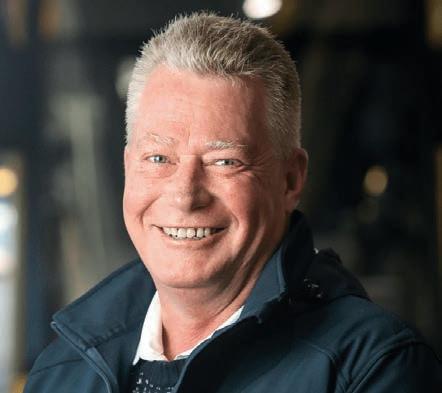
Flexible work: an IT perspective
Melville has a similar perspective for the IT staff across SUEZ.
“Many have said that people in IT can work anywhere,” he said. “We found that people need that interaction, which changed my perspective during the COVID years. Looking back on it now, there were times when we did not see team members face-to-face for months.
We have staff that love being out and about while we have other happy team members in front of the computer without needing to travel.”
Melville believes that encouraging a balance across the team is the most effective direction to head.
“I’ve always promoted a balance when it comes to flexible working hours,” he said.
“Most of the team likes to travel and get to sites around the country. I think that every three to six months, one team member will fly to a different site. That means trips to Perth, Adelaide, and Melbourne. It’s important to get around, to learn and bring back new knowledge.”
Remote work at the treatment plants

Cashman believes in the importance of empowering his colleagues.
“My approach has always been to empower my team to fill the entire space of their role,” he said.
“Although there are only three of us in the team, we talk every day and have a planned program of work that ensures we are achieving and exceeding the expectations
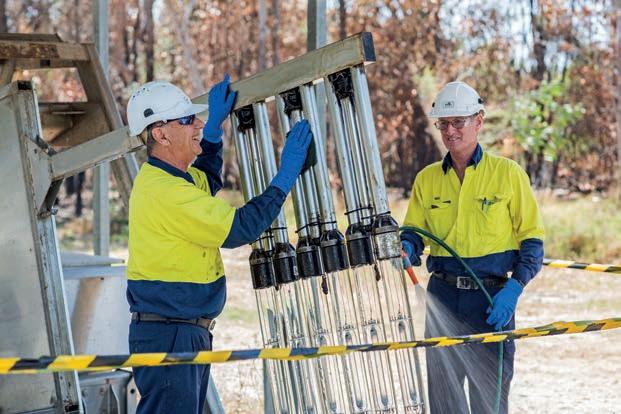
of our stakeholders. The way we work together ensures that flexible arrangements are embedded.
“We’re on-site when we need to engage and support our operational teams. We’re in the office when we need to deliver an output for our stakeholders. Sometimes we can work from home when it makes more sense.”
He pointed out that taking a broadbased approach that encourages independence and self-sufficiency has resulted in better outcomes for his team.
“Effectively, I become much more of a coach rather than relying on a managerial role title,” said Cashman. “The team delivered everything on our strategic plan in the last financial year. We met all the outcomes of our work program and completed an additional 100-plus emergent smaller projects over the financial year. This level of performance is only achieved through flexible working arrangements and great team culture.”
For more information, visit suez.com/en/australia-new-zealand
40 INSIDE WATER September/October 2023
Chris “Cashy” Cashman is the Safety and Wellbeing Manager.
Looking after employees across the country is a key focus of SUEZ Australia and New Zealand.


Measure, Benchmark, and Improve
In the challenging world of infrastructure project delivery, the key to success lies in the continuous cycle of “Measure, Benchmark, Improve.” This trio forms the backbone of performance optimisation and empowers project stakeholders. Voeu understands this.
THE WATER AND wastewater industries face several challenges, including aging infrastructure, increasing demand, and climate change. To meet these challenges, water and wastewater utilities need to be able to measure, benchmark, and improve project outcomes.
Measuring project outcomes involves collecting data on key performance indicators (KPIs) such as cost, schedule, and quality. Benchmarking involves comparing your KPIs to those across the industry. Improving project outcomes involves using the data from assigned measurements and benchmarks to identify areas for improvement.
Water and wastewater utilities can increase efficiency, reduce costs, and improve customer satisfaction by measuring, benchmarking, and improving project outcomes. The significance of each element is exposed to illustrate how they intertwine to create a seamless pathway towards project success.
Step 1: Measure - the foundation of informed decision-making
Measurement is at the core of the “Measure, Benchmark, Improve.”
Accurate data collection and analysis are the foundation for successful project delivery. Measuring involves gathering data related to various aspects of the project, including costs, timelines, resource allocation, quality metrics, and more. By measuring these KPIs, project managers gain insights into their project’s performance and health.
Technology is vital in facilitating data capture and tracking in the digital age. Sophisticated software systems, sensors, and monitoring tools enable real-time data collection, ensuring project stakeholders can access up-to-date information for analysis. This realtime data-driven approach allows for timely decision-making and swift course corrections, reducing the risk of delays and cost overruns.
Step 2: Benchmark - setting the bar for excellence
With the data accurately recorded and available, the next step is benchmarking. This involves comparing project performance against predefined standards, industry best practices, and historical data. Benchmarking provides context and perspective, helping project teams understand their current position and performance compared to established benchmarks.
Benchmarking goes beyond looking at financial metrics. It also encompasses safety performance, environmental impact, stakeholder satisfaction, and community engagement. By setting the bar for excellence through benchmarking, project stakeholders understand their industry standing and identify improvement areas.
Through benchmarking, projects can compare their performance against best practices and successful strategies in similar projects. This enables them to learn from past
experiences and adopt innovative approaches that have proven successful in other contexts. By leveraging the lessons learned from benchmarking, project teams can enhance their decision-making processes and optimise their project’s performance.
Step 3: Improve - fostering a culture of continuous improvement
Improvement is the ultimate goal of the “Measure, Benchmark, Improve” cycle. With data-driven insights and benchmarked performance, project teams can implement changes and enhancements to optimise project outcomes. This step is not a one-time event but a continuous process fostering a learning and improvement culture.
Improvement initiatives can range from small, incremental changes to significant process overhauls. It involves a systematic approach to address identified weaknesses and capitalise on strengths. By embracing a continuous improvement mindset, project stakeholders can adapt to changing circumstances, address challenges, and capitalise on growth opportunities. Collaboration and communication are vital during the improvement phase. Project teams should share lessons learned, including best practices and successful strategies. Transparent communication and feedback loops enable teams to learn from each other and foster a culture of collective improvement.
The synergy of “Measure, Benchmark, Improve”
The strength of the “Measure, Benchmark, Improve” cycle lies in its seamless synergy. Each step reinforces the other, creating a powerful feedback loop that propels
42 INSIDE WATER September/October 2023
FOCUS Workforce Management
Continuous improvement drives an improved workplace environment.
Measuring provides the data necessary for informed benchmarking, which sets the context for targeted improvements. The insights gained from benchmarking guide improvement efforts, ensuring they focus on the best possible outcomes.

Beyond financial metrics: a holistic approach
While financial metrics are vital, the “Measure, Benchmark, Improve” cycle encompasses much more. It encourages a holistic approach to project delivery that considers the immediate and long-term impact of the project. A successful project goes beyond financial profitability; it should also leave a positive and lasting impact on the environment, society, and all stakeholders involved.
By widening the scope of measurement and benchmarking, projects can deliver financial success and sustainable and socially responsible outcomes. By taking a comprehensive approach to performance evaluation, project stakeholders can ensure that their projects align with their organisation’s and other stakeholders’ values and aspirations.
Technology is pivotal in enhancing the “Measure, Benchmark, Improve” cycle in the digital era. From advanced data analytics to realtime monitoring, digital tools give project stakeholders insights and efficiency. Cloud-based platforms enable seamless collaboration among teams and stakeholders, fostering transparency and alignment. By leveraging the power of technology, projects can achieve new performance heights.
Digital tools facilitate real-time data sharing, enabling project teams to make data-driven decisions promptly. This enhanced visibility allows for proactive risk management, faster issue resolution, and increased accountability among team members. By embracing technology, project stakeholders can optimise resource allocation, identify areas for improvement, and ultimately deliver projects with higher efficiency and effectiveness.
Dynamic environment of project success
The “Measure, Benchmark, Improve” cycle is the bedrock of project success. Project stakeholders create a virtuous circle of excellence by
opportunities for improvement.
project performance against benchmarks and continuously seek improvements.
This cycle empowers them to adapt to a dynamic environment, optimise resources, and deliver projects that meet objectives and positively impact stakeholders.
As we embrace this continuous cycle, we pave the way for a future where infrastructure projects lead the way in efficiency, sustainability, and innovation. By fostering a culture of continuous improvement and leveraging technology to its full potential, project stakeholders can unlock the true potential of their endeavours and shape a brighter and more prosperous infrastructure landscape. The “Measure, Benchmark, Improve” cycle is not just a process; it is a mindset that drives organisations to deliver projects that make a meaningful difference in the world.
Voeu is a specialist water sector advisory and consulting practice that delivers advice and improvement projects for infrastructure owners, operators, and delivery providers.
For more information about Voeu, visit voeu.com.au
www.insidewater.com.au INSIDE WATER 43
SPONSORSHIP OPPORTUNITIES
NOW AVAILABLE
PROUDLY PRESENTED BY MHD
Thurs 20 June, 2024

The Women in Industry Awards recognise outstanding women leaders from across Australia’s industrials sector.
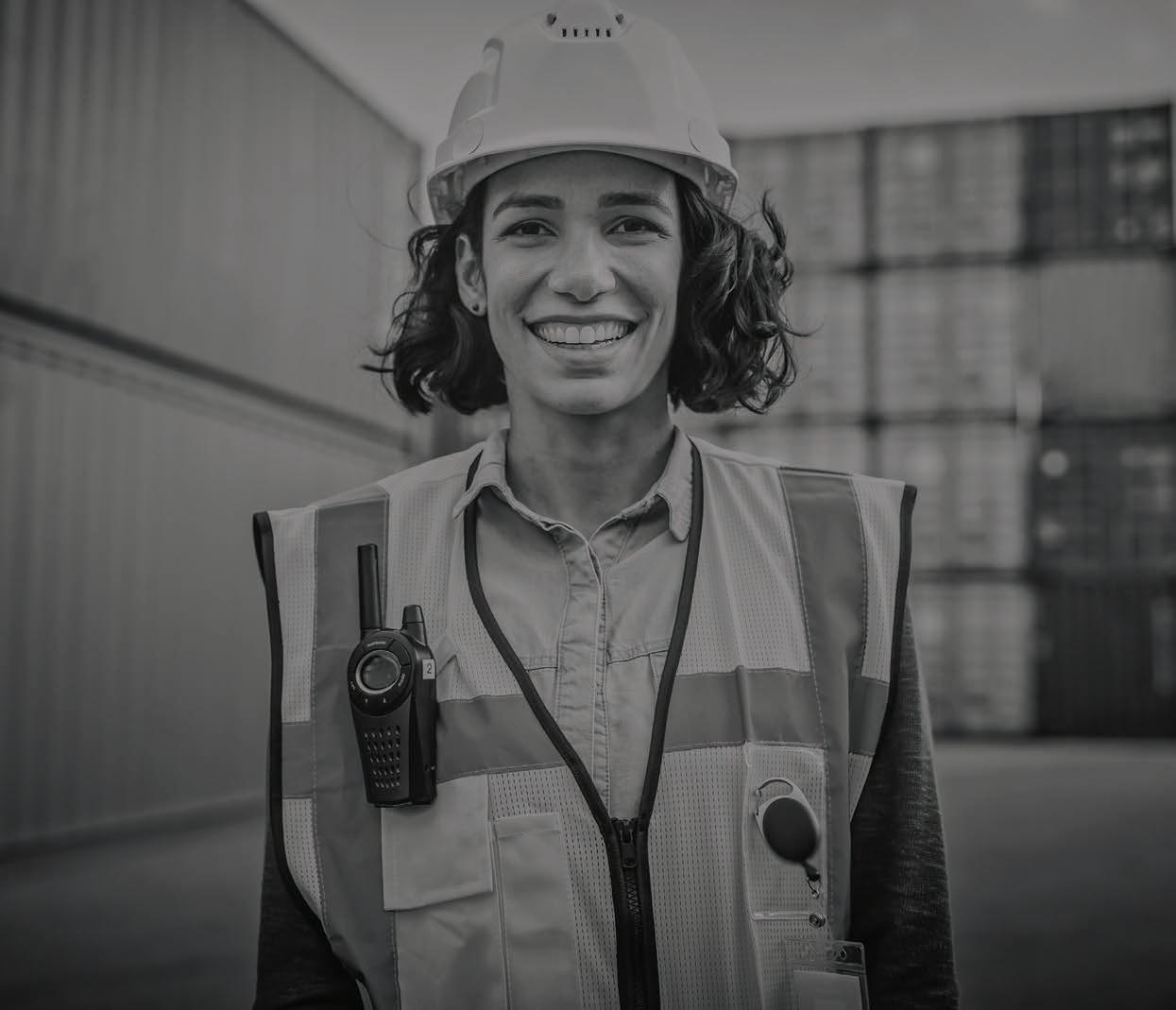
womeninindustry.com.au
upply PROUDLY SUPPORTED BY Australia
Map it out for biodiversity
species. Upon identifying the creek’s environmental significance, South East Water tailored its response to ensure the habitat was restored as quickly as possible.

KATRINA HALL IS the Environment Manager at South East Water. She was involved in developing a tool to identify environmental sensitivities to proactively protect our environment.

“The Environmental Sensitivity Map project arose from the need to have easily accessible information about environmental receptors across our service area,” she said. “When I arrived at South East Water, the project was already underway, but the team hadn’t worked out how to make the data easy to interpret. My main contribution was to guide how we compared the different environmental features and assigned sensitivity rankings.”
The map offers insights into 26 sensitivity categories across local waterways, land and marine environments. Typing an address into the map reveals information about sensitivities in the surrounding environment, with colouring to indicate a 1-5-point sensitivity rating. Ensuring the correct ranking focuses on two different aspects — irreplaceability and vulnerability. Determining these two separate factors when it comes to endangered
species and critical vegetation was challenging.
“Irreplaceability looks at the abundance of the species or vegetation,” Hall said. “It essentially looks at how common it is. The rarer the species, the greater its irreplaceability score. Vulnerability looks at what impacts different species and vegetation. We generally look at how resilient the species or environment is to stressors.”
Dwarf galaxias inspires project
The dwarf galaxias is a very small, scaleless, and elongated native freshwater fish and one of four members of the genus Galaxiella in Australia. These days, it is mainly found in the Mitchell River Basin near Bairnsdale, west of Dandenong Creek near Melbourne in Victoria. It is also found on Flinders Island in Bass Strait and in north-eastern and north-western Tasmania.
The small fish inspired the creation of the map following an operational response to a spill from South East Water’s sewer network into a creek in the utility’s network, discovered to be a breeding location for the

This incident highlighted the importance of quickly and easily identifying any environmental factors to ensure the best environmental outcome. The resulting database of information has been a gamechanger for South East Water, providing a single source of verified information about the environment the utility operates in.
“Now that we have this data, we need to look at how things impact individual species,” said Hall. “When we look at the dwarf galaxias, for example, we know they are sensitive to chlorine. It changes how we treat spills in areas that this endangered

www.insidewater.com.au INSIDE WATER 45
Biodiversity and software do not seem like obvious bedfellows. At South East Water, creating the Environmental Sensitivity Map provides the water authority with high-level information for risk management and incident response.
Kananook Creek runs parallel to the coast between Seaford and Frankston.
FOCUS Software
Dwarf galaxias
planning, assessments and regulatory requirements. The map provides an essential baseline of understanding for areas of ecological significance within its service area.
Charlie Littlefair, South East Water’s General Manager of Liveable Water Solutions, agreed that the map has enabled the utility to further deliver on its commitment to protecting the environment and has long-reaching benefits.
“We have a duty of care to be proactive stewards of the natural environment in which we operate to minimise the risk of harm, pollution or degradation. The Environmental Sensitivity Map allows us to quickly see what’s on our doorstep and what kind of risk management is required to protect our environment and support the community in which we’re operating.
“We’re also empowered with the insights to strategically map environmental sensitivities that guide the design of our assets and make biodiversity improvements in future capital projects,” Littlefair said.
Creating an accurate and reliable database
One thing not often considered in such projects is where to find accurate, up-to-date data. In the case of South East Water, it is accessing a range of publicly available datasets and bringing them together in one place. These datasets were obtained through Melbourne Water’s Healthy Waterways Strategy 2018-28, stream habitat indices, and the Victorian Biodiversity Atlas to determine locations for endangered species as well as various other datasets.
“We also have information about where all the community facilities are in our service area,” Hall said. “That includes things like surf life savings clubs, sporting ovals, yacht clubs, and agriculture and
aquaculture centres. We even look at where public health and aged care facilities are. That’s because they are all impacted by spills and other such situations.”
South East Water partnered with Alluvium Consulting Australia and DiscoverEI to develop the map and dashboard.
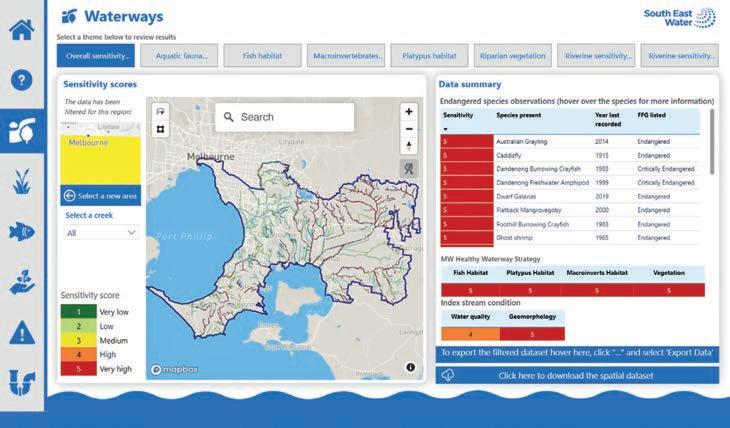
Impact of the map
Hall believes that the Environmental Sensitivities Map is now the go-to destination in the event of any spill.

“We have had fantastic uptake from our operations people in this regard,” she said.
“The big advantage is that they look at the map and instantly have access to location-specific environmental data. They only need to reach out to environmental specialists if they need more help. It’s been very empowering because, after hours, those team members don’t necessarily need to call on specialists. They have a lot of information and can make better decisions for spill responses.”
The next stage of the map is to add some additional datasets that focus on the environmental condition of estuaries using the recently developed Victorian Index of Estuary Condition (IEC). This would further support South East Water’s project areas.
The project team uses the information in their initial environmental activity description. It allows our teams to properly assess the impact of their activities and what they can do to minimise the impact on any species in the area. A significant benefit to the project
team is that all the data is in one space. Hall believes this is an improvement over the option to look at multiple data sets and potentially make errors.
What is the future of the project?
The Environmental Sensitivity Map provides numerous opportunities to expand its scope. Hall believes there are plenty of opportunities to use the map for biodiversity enhancement – ideally beyond South East Water’s service area.
“As we build that biodiversity enhancement framework, we may find that we need to modify the Environmental Sensitivity Map over time,” said Hall. “At the same time, I’d love to expand its usage to other water authorities in Victoria. If we were working with other water authorities and organisations, everyone would have access to the same data and work off the same datasets.”
The economies of scale generated from working together would improve opportunities across Melbourne and Victoria, according to Hall. She looks at the Oil Spill Response Atlas (OSRA) as inspiration for what can be done.
“There is enormous potential in what we could achieve together. Even though the water industry is generally very low-impact, things still go wrong. We are working to satisfy our customers, who have told us they value their waterways and green spaces. The Environmental Sensitivity Map will help maintain those areas.”
For more information, visit southeastwater.com.au
46 INSIDE WATER September/October 2023
FOCUS
The Environmental Sensitivity Map helps users understand what protected species live in a specific area.
Software

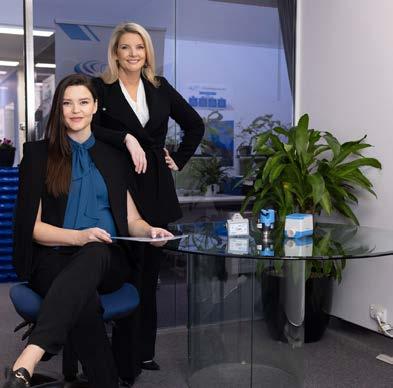
www.insidewater.com.au ISSUE 08 SEPTEMBER/OCTOBER 2023 Optimism key to a happier workforce Revolutionising leachate management Sailing the seas of safety and wellbeing Insights into sensors and IoT devices for a better water future WaterGroup future shaping the of water Inside Water is a new multi-platform publication for the Australian water industry. It is focused on the people, products and technology that enable sustainable and innovative management of Australia’s water resources. Visit www.insidewater.com.au, select Subscribe and use our easy online form to subscribe today! SUBSCRIBE TODAY
Gladstone invests in advanced water metering
Gladstone Regional Council has made the strategic move to implement Taggle Systems’ advanced water meter infrastructure to secure the region’s water sources for the future.
GLADSTONE REGIONAL COUNCIL
has commenced Stage 1 of the whole-of-region, multi-year project by installing nearly 1300 advanced water meters to residential and commercial properties in Agnes Water, Seventeen Seventy, Miriam Vale and Bororen.
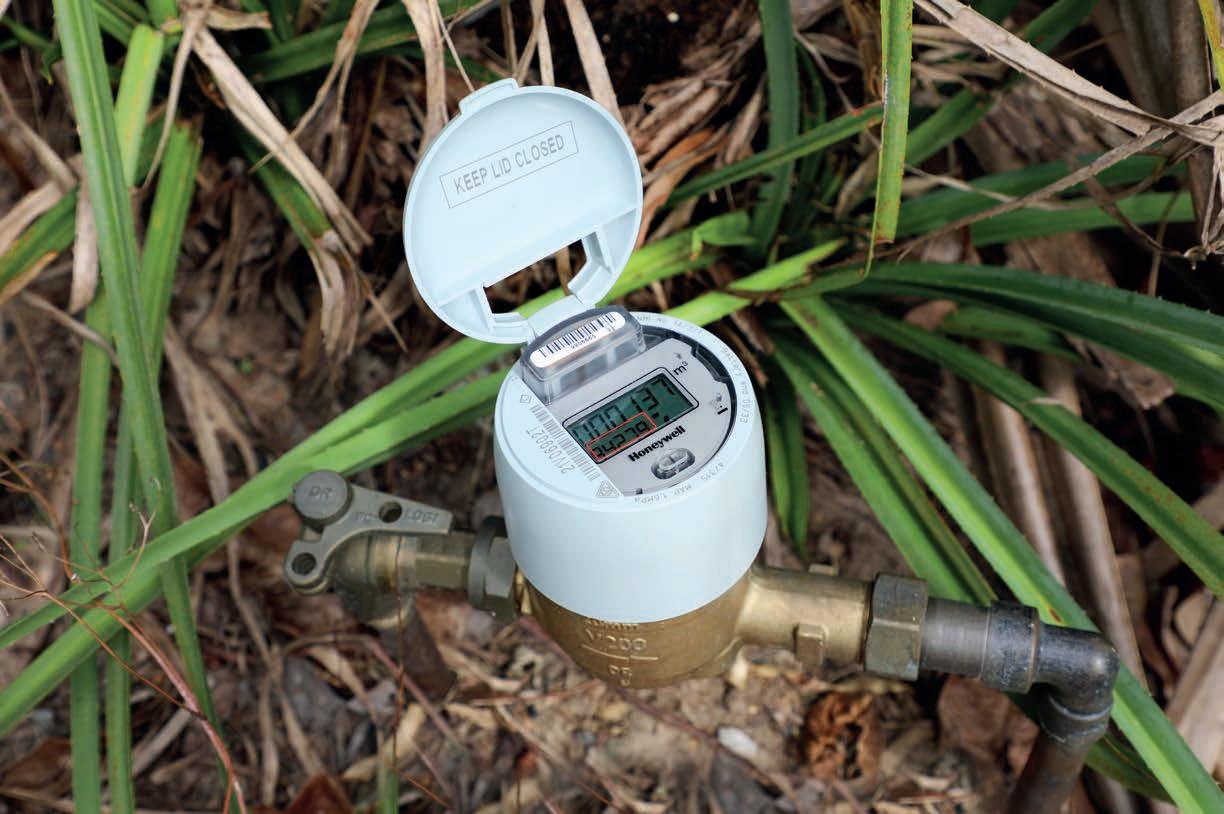
“The advanced water meter technology will provide significant benefits to residential households and businesses,” said Gladstone Region Mayor Matt Burnett. “It enables early detection of leaks, offers data and information accessible online for users to monitor and manage their water consumption, and empowers Council officers to respond more effectively to enquiries regarding water connections.”
Why adopt advanced water metering?
“Many councils and water utilities across Australia who have introduced
advanced water meter technology have already experienced substantial reductions in water wastage, benefiting the community, the council, and the environment,” said Mayor Burnett.
Key factors influencing Gladstone
The sandy soil composition in coastal areas increase the risk of undetected water leaks. The sandy soil makes it harder to detect water loss, however this technology can support residents and Council to quickly detect leaks.
The leak detection function in the advanced water meters contributes significantly to water conservation efforts. For these reasons, Agnes Water and Seventeen Seventy were chosen for Stage 1 of the project. Miriam Vale and Bororen have a combined population of less than 1000 people with locality strongly contributing to their inclusion in
The Taggle Systems advanced water metering system supports Gladstone Regional Council’s sustainability efforts.
Stage 1 of the project.
The water sources in the area are heavily dependent on rainfall and the Baffle Creek. It has led to strict water restrictions for these communities during drought and dry periods.
The opportunity for remote meter reading enhances Council’s ability to manage the water network efficiently.
Improved customer service
Equipping property owners, residents, and commercial properties with water consumption data through a customer portal will enable the Council to create awareness and serve the community more efficiently.
Council can support the community with early leak detection to reduce the impact of high water usage.
This will be an improvement on the current process, where potential leaks are identified during six monthly reading cycles.
The customer portal will help residents access and visualise their own water usage in near real-time and they will be able to set their own water alerts to lessen water bill surprises.
48 INSIDE WATER September/October 2023
FOCUS Sensors
Automate billing and property changes
Other goals for Council are to improve on water reading accuracy and improve the asset data of replaced and new meter installations against properties through the automation process and the removal of manual interventions.

Network water losses
The advanced water meter project will allow residents and Council to take a smarter approach to sustainable water management. The availability of near real-time data will improve Council’s ability to detect water losses in its networks in a timely manner, drive down unaccounted water, and increase overall water security now and into the future.
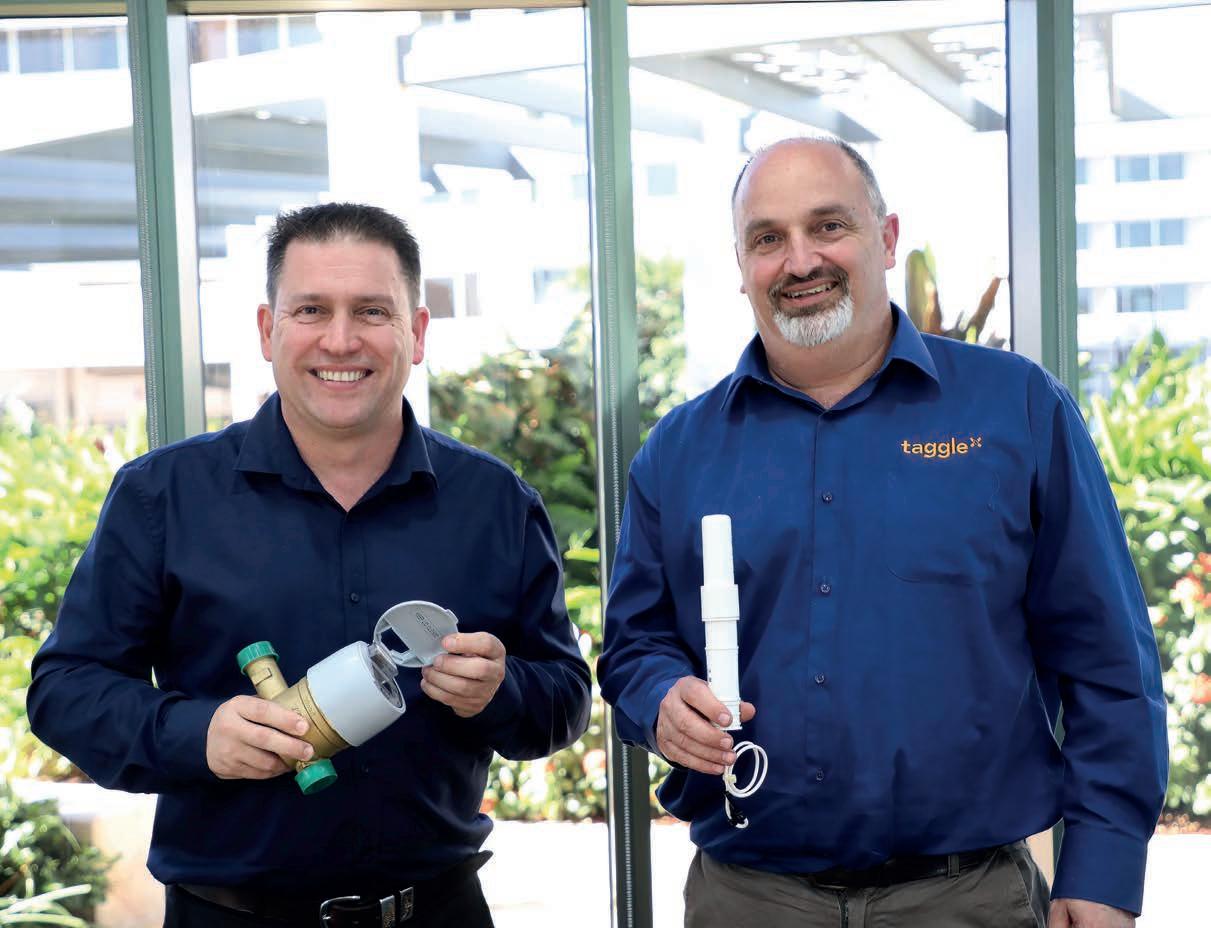

How will the community be able to access their water consumption data?
“The information will be made available to property owners, tenants and businesses via the MyWater customer portal which will be launched shortly after the installation of the meters,” said Mayor Burnett.
Long-term sustainability
Mayor Burnett emphasised that advanced water metering is one of many actions the Council is taking to enhance water resource management and infrastructure for long-term sustainability.
He added, “This upgrade program is an exciting innovation for our community and will ensure Council
Seventeen Seventy is a
can continue to provide a safe, reliable, and cost-effective water supply well into the future.”
Visit www.gladstone.qld.gov.au/ advanced-water-meters for more information about the project or www.taggle.com.au for more information about the system.
www.insidewater.com.au INSIDE WATER 49
Gladstone Mayor Matt Burnett (left) and Mark Matijevic (right), Sales Director at Taggle Systems.
picturesque region in Central Queensland.
Barwon Water utilises kwik-ZIP spacers
kwik-ZIP product range is widely utilised around Australia. In the past few months, it has supplied products to McConnell Dowell and Barwon Water on a couple of major infrastructure projects.

BARWON WATER REPLACES up to 20 kilometres of old and damaged pipes every year at an annual cost of around $4 million. This ongoing maintenance program minimises repairs, reduces supply interruptions and ensures continued water quality. Their service area is centred on the city of Geelong and the surrounding areas.
Where possible, pipes are replaced using trenchless technology, reducing the impact on residents and the local environment. Barwon Water selects one of two models for trenchless technology. One
bores horizontally underground before pulling new pipes through the bore. It is the preferred method when a new alignment is needed.
Barwon Water reached out to McConnell Dowell, who have been utilising kwik-ZIP spacers on the projects to achieve this goal. McConnell Dowell used some of the HDX/HDXT casing spacers.
HDX/HDXT casing spacers
The HDX and HDXT casing spacers are flexible in their use. They can be used on many pipe materials,
(OD) from 100mm to 1600mm and beyond. They can also handle a range of different annular clearances, given the range of runner heights available across the range.
The casing spacers help position the pipe properly within the casing or host pipe, ensuring centring and restraining or simply providing protection during installation. They are designed to be installed quickly and easily to support the carrier pipe, offering a low coefficient of friction wear pads. The pads resist abrasion from the casing or host pipe surface, assisting with installation. The antislip rubber pads also prevent spacer dislodgement during installation. The load-sharing runner system maximises the spacer weightbearing capacity while reducing
FOCUS Products
The plastic spacer materials resist chemicals and oils, even when the spacers are immersed for long periods. Similarly, there are no metal parts to promote corrosion, and the lack of lead content makes them compatible with every potable water application.
The HDX/HDXT series casing spacer stations the pipe to promote even grout cover. If the pipe is not to be grouted, the HDX/HDXT will support and isolate the carrier pipe plus its contents for the life of the installation.
Marshall DN560 HDPE Relocation Project
On a recent water main relocation project, McConnell Dowell utilised Kwik-ZIP HDXT-58W spacers to facilitate the slip-lining of a 560mm HDPE carrier pipe over a 260-metre run. This project also used a 1026mm ID RC Jacking pipe.

While not used on this project, Kwik-ZIP HDXT-58W spacers can accommodate its kwik-ROLLER wheels. These clip-on wheels are suitable for longer runs to minimise wear and reduce the friction coefficient.
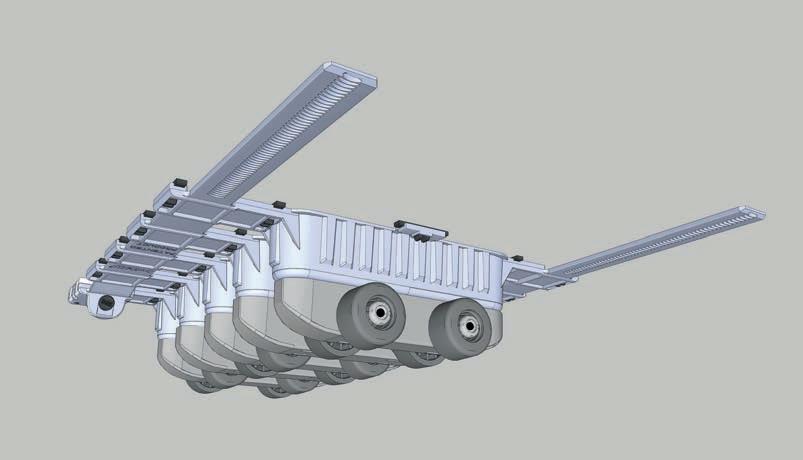
Kwik-ZIP HDXT-58W spacers were installed as per Melbourne Water Retailer Agencies (MRWA) standards. As the pipes would not be fully grouted after installation, the spacers are required to support the pipe and water for the life of the installation (Pipe weight – 83kg/m (empty) and 246kg/m (full)).
“Kwik-ZIP spacers were simple and quick to install, and the sales team promptly answered any queries,” said Paul Pomfret, Senior Project Engineer at McConnell Dowell.
South Geelong Station water main relocation project
On a similar water main relocation project, McConnell Dowell utilised
Kwik-ZIP HDXT-58W spacers. It was to facilitate the slip-lining of a 660mm OD MSCL Steel Mains Sintakote carrier pipe over a 54-metre run. The project also used 800mm ID RCP casings.
“With limited room and unable to utilise our pipe rollers, we had some concerns about pushing the MSCL pipe. The 54m pipe would have been a challenge, but the Kwik-ZIP spacers allowed us to easily install using a 14T Excavator,” said Pomfret.
About kwik-ZIP spacers and centralisers
combinations and provides flexibility to deal with project alterations.
Kwik-ZIP spacers have no metal parts and are made from Kwik-ZIP’s engineered thermoplastic blend that is flexible, tough and has a low coefficient of friction.
Kwik-ZIP’s HDXT & HDX Series spacers have been appraised by the Water Services Association of Australia (WSAA). The WSA PS-324 product specification prescribes casings spacer requirements for correctly protecting carrier pipes when installed inside casings.
www.insidewater.com.au INSIDE WATER 51
McConnell Dowell utilising kwik-ZIP HDXT58W spacers to facilitate slip-lining of a MSCL Steel Mains Sintakote carrier pipe.
The clip-on wheels help roll
Women in Industry Awards head to Sydney in 2024
Supporting outstanding women that drive change and break down barriers is the background for the Women in Industry Awards. It will be heading to Sydney in 2024.
THE WOMEN IN Industry Awards recognise and reward the achievements of women working within the mining, engineering, manufacturing, process control industries and commercial road transport industries. It aims to raise the profile of women within industry, as well as promote and encourage excellence. Nominations are already open for the 2024 Women in Industry Awards, which will take place in Sydney on Thursday, 20 June.
2023 Awards review
2023 saw a record 160 nominations across 10 categories, which was a 95 per cent increase on 2022’s awards. The gala dinner sold out for the first time in its history, recording a 55 per cent attendance increase compared to 2022. Thirty-two individual media mastheads carried marketing about the Women in Industry Awards.
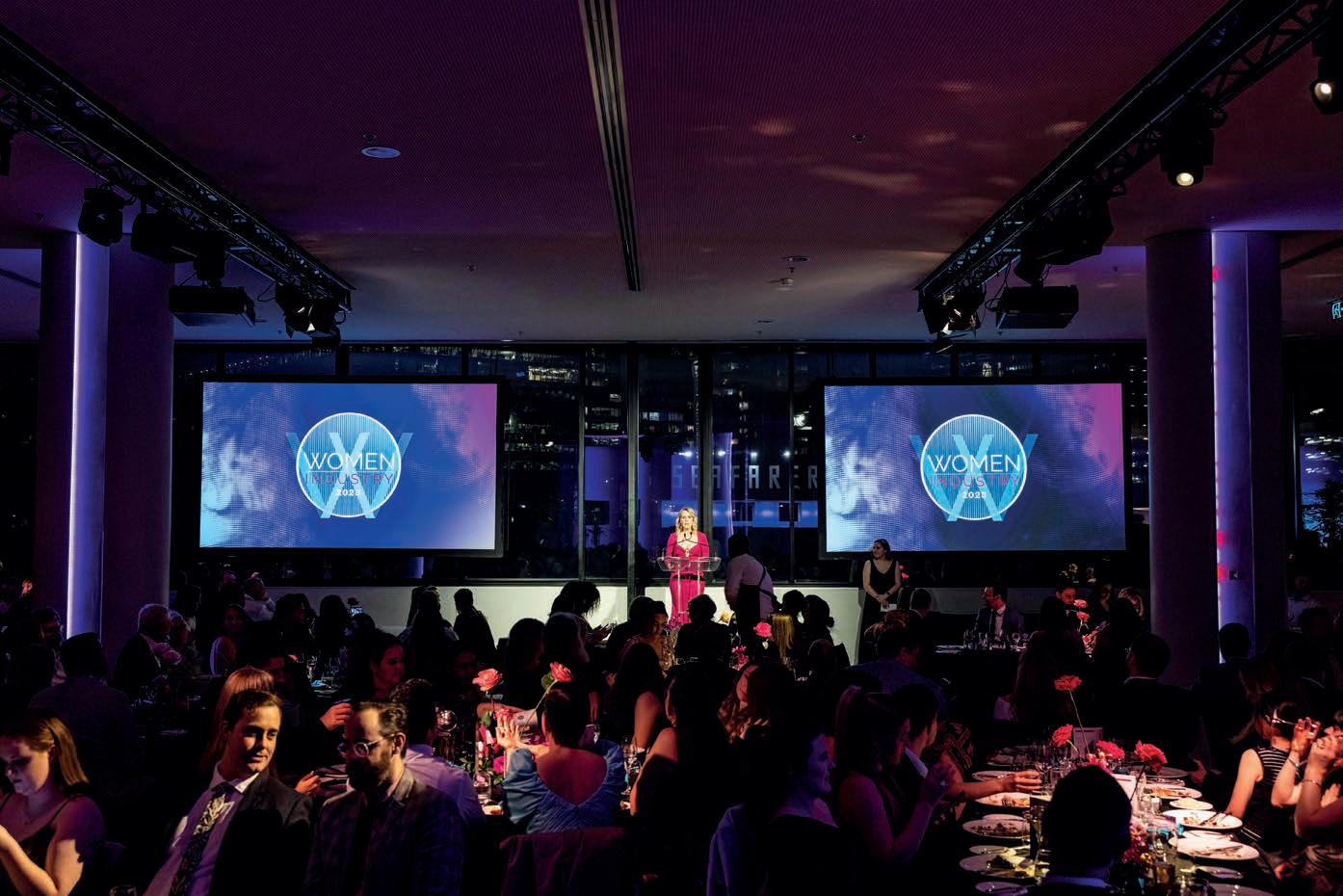
The judging panel had a tough time getting to a finalist shortlist and deciding the winners. In front of their peers across the country, ten category winners and the Woman of the Year were announced.
Australian Mining, PACE, Manufacturers’ Monthly, MHD Supply Chain Solutions, Prime Mover, Inside Construction, Waste
Management Review, Inside Water, Rail Express, Roads & Infrastructure Australia, Energy Today, Quarry and Australian Bulk Handling Review are partnered to acknowledge the exceptional women who have achieved success through their invaluable leadership, innovation and commitment to their sector.
Woman of the Year ready to excel Giselle Phillips from Fredon Queensland took out both the Woman of the Year (sponsored by Fulton Hogan) and the Safety Advocacy Award (sponsored by Komatsu) in 2023. The latter seeks to recognise an individual working actively to improve safety for their industry.
Phillips is an HSEQ Advisor for Fredon’s Queensland office. She described herself as a dynamic driver of positive change, making a difference by being a positive and supportive influence, sharing and imparting information or implementing change. She’s been in the role for more than two years, supporting various projects throughout the state.
Phillips was thrilled to have won both the coveted Woman of the Year and Safety Advocacy Awards.
“This acknowledges the dedication
and passion I’ve put into my work as a safety professional,” Phillips said. “In my role at Fredon, I have taken almost every woman on their journey. I’ve advocated for them. I have put them up for submissions. I’ve interviewed them. I have listened to them, and we are all in the same boat. We are not in competition with each other. We
Full list of 2023 winners:
• Stefanie Frawley (TMX Global) – Business Development
Success of the Year
• Trudy Grimshaw (Department of Finance, Western Australia) – Excellence in Construction
• Elsa Antunes (James Cook University) –Excellence in Engineering
• Kristi Riordan (Harvest B) – Excellence in Manufacturing
• Ashara Moore (BHP) –Excellence in Mining
• Coralie Chapman (Humes Concrete Products) – Excellence in Transport
• Jemma Walshe (Fulton Hogan) – Industry Advocacy Award
• Teagan Dowler (The BCW) – Mentor of the Year
• Sophia Kurianski (Jinolo) –Rising Star of the Year
• Giselle Phillips (Fredon QLD) – Safety Advocacy Award and Woman of the Year
52 INSIDE WATER September/October 2023
FOCUS Events
Claire Hooper MCing, the 2023 Women in Industry Awards
need to advocate and help each other get where we need to be.”
Sponsors already on board
Women in Industry is pleased to announce that Fulton Hogan has renewed its sponsorship for the 2024 edition.
“Fulton Hogan is proud to sponsor the Women in Industry – Women of the Year award for another year in 2024,” said Fulton Hogan CEO Graeme Johnson. “This sponsorship demonstrates our commitment to supporting and driving change within predominantly male industries, doing what we can to make heavy industry more attractive and accessible for women to join and stay.
“Fulton Hogan recognises that diversity is not only essential for us to change, adapt and grow, but it also good for business and results in happier workplaces with a better culture leading to better retention of our people.”
Prime Creative Media and the Women in Industry Awards team are excited to have Fulton Hogan on board.
On a similar note, PACCAR Australia will be supporting the Excellence in Manufacturing Award. PACCAR has a long and proud history of supporting women in all areas of its global businesses.
“We recognise programs such as Women in Industry Awards help promote women more broadly,” said Michael Long, Director Sales and Marketing, PACCAR Australia. “Being part of the awards helps us further our goal of celebrating and championing inclusion and diversity in the workplace.”
SEW-DRIVE is a proud sponsor of the Excellence in Engineering Award. As a manufacturer of heavy industrial parts, they are thrilled to be supporting the Women in Industry Awards.
“Knowing how vital gender diversity is in our manufacturing industry drives us to work together to recognise women’s work and support them in fulfilling their goals,” said Laura Arias – Senior HR Business Partner. “Once again, we have the pleasure of sponsoring the Women in Industry in 2024.”
Atlas Copco is sponsoring the Rising Star of the Year award. This award recognises an individual who has shown significant promise within their chosen industry or who has reached new goals at the start of their career.
“The awards are an opportunity to recognise the contribution of women in industry and their amazing examples for the next generations,” said Fiona Halliday, HR Business
the evening.
sponsors the awards to show our commitment to females in nontraditional industries and how we can find a better way towards equal representation. We love taking our team to the celebration and showing them the example that is set by all of these amazing women.”
How to get involved Nominations and sponsorship opportunities are now open. If your business wants to nominate a leader in their field or sponsor the Women in Industry Awards 2024 (or even both), you can head to the Women in Industry website.


For more information, visit womeninindustry.com.au

www.insidewater.com.au INSIDE WATER 53
Partner at Atlas Copco. “Atlas Copco
It is an opportunity to have staff in your organisation recognised. Networking with colleagues across the industry is an important aspect of
Optimism central to a happier workforce

“EVERY GREAT LEADER in the world is infectiously optimistic, but it’s not the guys standing at the podium giving the big speech. It’s the person who can unlock the optimism in the team.”
That’s the Chief Optimism Officer for The Centre for Optimism, Victor Perton. His purpose is to help everyone become more optimistic and foster realistic and infectiously positive leaders.
When someone speaks to Perton, they are filled with his incredible passion. It’s not to take anything away from other people and their passions. Perton is so ebullient, it seems almost impossible to challenge this joy.
His interest in the water industry
In the eyes of Perton, his interest in water arises from being human. When it gets to the water industry, his activist perspective started as a young child.
“I lived on the banks of the Merri Creek, which in my day was heavily polluted,” he said. “It used to capture the effluent from factories in Coburg and the northern suburbs of Melbourne. Yet, as kids, we used to swim, wade, and fish in it. It was a very degraded environment. I was eight years old when I gave my first speech at the Moreland branch of the Rotary Club. It was about pollution and our need to be active in this space.”
Perton pins his interest in regenerative water during his time on Merri Creek’s banks. These days, Merri Creek is a beautiful natural environment with walking tracks
and good-quality water flowing through it.
“Following my speeches at Rotary Clubs and Young Liberal Party branch meetings, I had many conversations with Morris Williams, then Member for Doncaster,” he said. “Often, our topic of conversation focused on the power and influence of the then Melbourne and Metropolitan Boards of Works (MMBW, now Melbourne Water), along with the power of its leader at the time, Alan Croxford.”
Croxford was known as The Baron of the Board, partly due to his expansion of responsibility and
Victor Perton (right) has always had a positive outlook when dealing with staff at Yarra Valley Water.
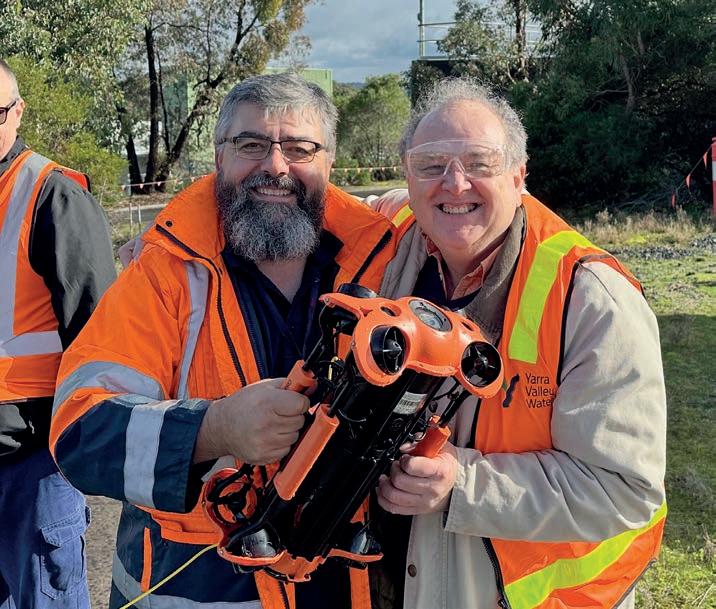
power for the MMBW. Two of his most significant achievements are the 1971–1974 Masterplan that set the future growth of Melbourne separated by green wedges, as well as the creation of the metropolitan park system. Croxford and Williams worked together to establish the numerous green parks around Melbourne, securing its future as the Garden State.
Politics and the water industry collide
During his time as the Shadow Minister for Conservation and Environment, Perton tended to spend much of his time on the challenging battle around creating marine national parks. However, a significant amount of time and effort was put into water quality.
“Over the 25 years I spent in
54 INSIDE WATER September/October 2023
While optimism may not be the first thing that comes to mind when people think about water utilities, VicWater director Victor Perton provides a unique perspective that could drive change in managing workforces.
ASSOCIATIONS VicWater
Parliament, I would pester the minister with questions on notice and Freedom of Information Applications on water quality,” he said. “Whether it’s the Kananook Creek in Frankston or any other waterway in Victoria, I was asking questions and gathering information about water quality.”
These days, Perton considers his work in that field essential. He was involved in the Victorian Act 1989 and the 1995 legislation that brought about the 18 Victorian water corporations that exist today. There are also the efforts made by the Environmental Protection
Agency (EPA) Victoria that can be seen every day across the state. “These days, we might get alerts about the water quality in Port Phillip Bay, around the beaches. These alerts only pop up after heavy rain,
believes there is enormous potential in the
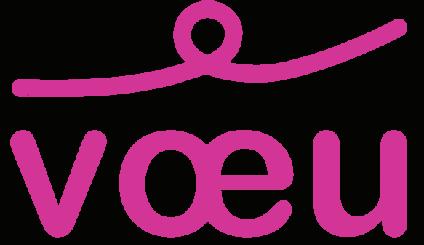
Waste to
and my Port Melbourne Beach has clear water with white sands close to Melbourne’s urban centre. It’s the work of Premiers like Henry Bolte and Rupert ‘Dick’ Hamer that laid the groundwork for the continuing
Commercial advisors and consultants
Commercial advice and expert opinion to support senior leaders
Organisational analysis, benchmarking, and dashboards

Bid leadership, tender development, and submission review

Development of operational and capital asset programs
Estimating and project controls systems for progress, cost and risk
Victor (left)
Wollert
Energy Plant.
Industry expertise, capacity, and focus to achieve business ambitions
�
�
� �
�
to deliver better value and less risk Interim executives during change or recruitment � User contactus@voeu.com.au | www.voeu.com.au | Delivering advice and improvement projects for infrastructure owners, operators and delivery providers
Strategic procurement
work on environmental protection and water quality and efforts by governments of all persuasion and the community,” he said.
Perton noted that Australia’s water industry is regarded as the envy of the world. Despite the many ideas that came about from southern California, Perton has seen how southern California is now looking at Victoria to improve its own systems.
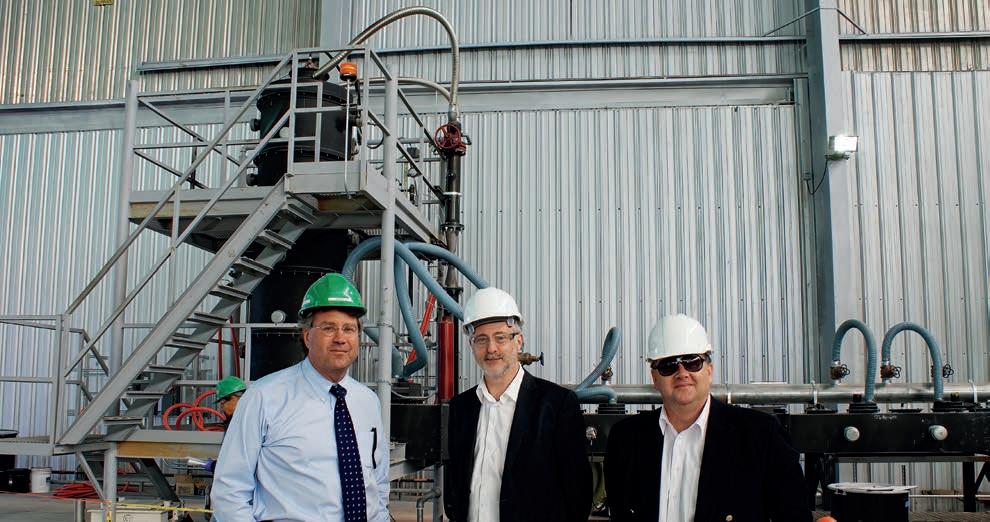
“As Commissioner to the Americas, I learned how globally forwardthinking the Victorian regulatory system and its water sector were, especially regarding water pricing and travelable water rights,” he said.
“I recall accompanying a Victorian delegation visiting the Metropolitan Water District of Southern California and its chair Tim Brick talking about 10 Victorian innovations he would bring to California. There was also the presentation by David Downie at the World Bank and World Bank officials’ approving questions and commentaries. We also need to remember the success of Rubicon entering the Australian market. Of course, it has all helped us truly understand the relationship between the irrigation systems of north-west Victorian and California.”
Leadership and optimism
As the founder of the Australian Leadership Project, Perton seeks to celebrate, understand, and improve Australian leadership. It came about because he was confounded by the negativity of language around leadership in Australia.
“I’d had several lucky years as the Commissioner to the Americas, and then working with the G20,” Perton said. “It was clear that the rest of the world thought we are pretty good. It wasn’t hard to meet with top business leaders and organisational heads. However, I found that on my return, there was an incredible
volume of negativity and cynicism around leadership in Australia.”
The Australian Leadership Project interviewed about 2,500 people over two years, covering every aspect of the corporate ladder. It found that Australian leadership is actually pretty good. However, there was a separate aspect that Perton discovered as a result of this research.
“Part of showing that Australian leadership is pretty good is breaking through the cynicism. The problem is not a problem of leadership, but it is the fog of pessimism,” he said.
Perton refers to an article in the Jerusalem Post by Rabbi Moshe Taragin. The rabbi spoke about the age of pessimism. He is not alone in this thinking, as Perton believes that the Australian community is caught in a fog of pessimism. Similarly, economist Umair Haque called it a tsunami of pessimism sweeping the glove.
“We have entered an era without precedent, certainly not in living memory,” said Singapore Senior Minister Tharman Shanmugaratnam.
“It has led to a loss of optimism almost across the world.”
The House of Commons leader, Penny Mordaunt, once wrote, “The faultline in politics at the moment is not between left and right but between optimists and pessimists. We need optimists for the next shift.”
In hearing all these comments, Perton believes that a leader needs to be an optimist. It led to the creation of the Centre for Optimism.
The Centre for Optimism
Perton and his colleagues established the Centre for Optimism in response to this rising tide of pessimism. It’s driven by a mission to nurture hope and positivity. The Centre draws from a lifetime of optimism, four years of intensive research into Australian leadership, and five years of research on optimism focused on the questions, “What makes you optimistic?” and “What makes you feel optimistic?” We aim to lift the pervasive ‘fog of pessimism.’
“Creating bases for optimism has to be our central task everywhere in the world and through global collaboration. We must create bases for optimism to see ourselves through this long storm and to emerge intact; emerge a better place, and it can be done,” said Shanmugaratnam.
Perton has a range of familial influences that led him to be the optimist that he is today. He has shared the same anxieties, grief and failures as everyone else. However, he believes that things will work out alright in the end.
“I was born in Australia. As such, I
56 INSIDE WATER September/October 2023
ASSOCIATIONS VicWater
Victor Perton (right) with Gavin Jennings (centre) at a carbon capture site.
am fortunate that the traumas my ancestors and family suffered on the way to Australia strengthened them and their realistic optimism,” he said. “My ancestors embodied the belief that optimism is a state of mind, not dependent on the state of the world. They held firm to resilience, fuelled by their unwavering faith in the better aspects of humanity.”
Since stumbling across the fog of pessimism that exists across Australia, Perton makes a point of asking people, “What makes you optimistic?” Following the publication of his book “The Case for Optimism: The Optimists’ Voices,” Perton was struck by people’s desire to learn more about how to be optimistic and the yearning for stories of optimism and hope. For most people, they have never been asked about their optimism before.
“I presented the case for optimism in keynote speeches, workshops, roundtables, and retreats in corporate environments, universities, schools, community groups, and even in prison,” he said. “As Dominic Barton, the chairman of Rio Tinto and chancellor of the University of
Waterloo, said to me, every great leader in the world is infectiously optimistic. Still, it’s not the guys standing at the podium giving the big speech. It’s the person who can unlock the optimism in the team.”
Why laughter is important as part of optimism
At the time of writing, Perton had just returned from a trip to Samoa. One of his findings was that Samoan culture is centred around smiles, humour, laughter, family and faith.
“Samoan culture makes me optimistic,” he said. “Their approach to humour is part of a small group of countries – Samoa, Australia, New Zealand, and maybe Ireland – all have self-effacing humour as part of their culture.”
Perton believes that this humour comes from egalitarianism –something that Australia prizes enormously. Perton is convinced that this is a vital component of Australia’s leadership. People all over the world have influenced him in this regard, including Ros BenMoshe. Ben-Moshe is a positivity resilience and laughter as therapy
academic, researcher and author. Another influence was Reader’s Digest and its section called “Laughter Truly is the Best Medicine.”
“Whether we’re talking about physical or mental health, it showed that we can have a laugh,” he said. “Our whole culture is around laughter and telling jokes. Andrew Jeffers from Wannon Water believes in the idea of coming to work to have some fun. People should go to work with a smile on their face and share that smile with the people they work with.”
Perton has already found a positive take on the development of artificial intelligence – it helps him write new jokes and limericks. He prepared one such limerick about the water industry.

There once was a water engineer Who worked with recycling, no fear Making the world more sustainable, Turning effluent into something valuable, Clean water for all, far and near!
For more information, visit www.centreforoptimism.com
www.insidewater.com.au INSIDE WATER 57
Victor Perton is a director of Yarra Valley Water.
The lighter side of water
To finish each issue, we aim to look at the lighter side of water and waterrelated issues. If you’ve seen an amusing story, let us know so we can consider it for the next issue.
Flushing away sporting stress
During movies and sporting events, we do our best to hold the need to use the bathroom until an appropriate moment.
This was extremely clear for Australians across the country and around the world during the 2023 FIFA Women’s World Cup. Melbourne Water was one water authority that reported extensively on their resident’s water use throughout the tournament’s latter stages.
What’s a flush factor?
For Melbourne Water, the flush factor represents changes in water use patterns. It can pick up increases in toilet flushings across their network, representing a break in play.
Traditionally, Melbourne Water has used this to represent how exciting an AFL grand final is. Still, with the significant interest in the Women’s World Cup, there was no doubt that the flush factor would come into play for Melbourne Water.
It’s measured by tracking the flow rate in megalitres per day for that
specific point in time. That way, the volume of water flowing through pipes can be measured relative to distinct time periods.
Matildas vs Denmark
The game between Australia and Denmark on August 7 was the first indicator of behavioural change. While fans at the Olympic Stadium were treated to an excellent match, water flows were mostly greater than those at the same time the previous day. The biggest spikes came at half-time (13 per cent) and full-time (10 per cent).
Given the TV ratings that exceeded 3.5 million people across the country, there’s no surprise that there were big spikes at those key times. With the Matildas controlling much of the match, viewers probably felt free to use the toilet whenever they wanted.

Matildas vs France
TV ratings passed 4.43 million for this incredibly tense match. With no goals scored during the 120 minutes,
people left off their toilet breaks for as long as possible.
Melbourne Water reported huge drops in water use during the match, with spikes at half-time, the end of regulation time, the end of the first half of extra time, and the end of the second half of extra time. When it came to the relief of defeating France on penalties, water flows spiked by more than 15 ML/D in the space of about 20 minutes. It represented a 28 per cent increase in water use.
Matildas vs England
While official reports suggest a TV audience of 11.15 million people, further research suggested that the total national audience was about 17.16 million people, representing about 64 per cent of the population. Water use dropped dramatically from about ten minutes before kickoff. Like other matches, there were significant spikes in water use at the end of half-time and full-time. The spike at full-time represented a 33 per cent increase in water use.
58 INSIDE WATER September/October 2023
FOCUS The last word
Holding on during a tight game is not unusual.
CREATING CYCLES. FOR LIFE.
CREATING CYCLES. FOR LIFE.
We drive the success of our people, foster collaborative relationships and champion an inclusive environment.
We drive the success of our people, foster collaborative relationships and champion an inclusive environment.
SUEZ – your trusted partner for circular solutions in water www.suez.com/en/australia-new-zealand
SUEZ – your trusted partner for circular solutions in water www.suez.com/en/australia-new-zealand








WE SOLVE YOUR WATER CHALLENGES LEADERSHIP IN GLOBAL WATER TECHNOLOGY
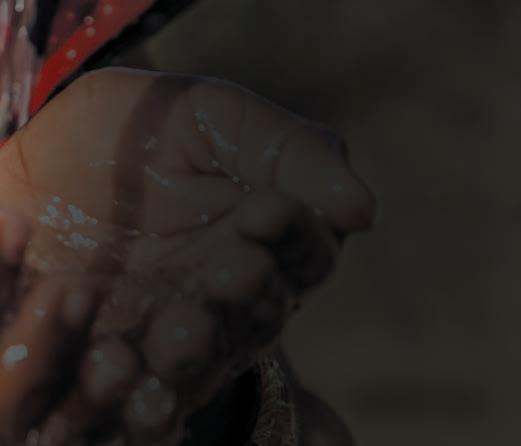




We are a global team unified in a common purpose: creating advanced technology solutions to the world’s water challenges. Developing new technologies that will improve the way water is used, conserved, and re-used in the future is central to our work. Our products and services move, treat, analyse, monitor, and return water to the environment, in public utility, industrial, residential, and commercial building services settings. We also provide a leading portfolio of smart metering, network technologies, and advanced analytics solutions.

SALES - SERVICE - RENTAL
13 19 14 | xylem.com/au | solve@xylem.com
@xylemanz



























































































































